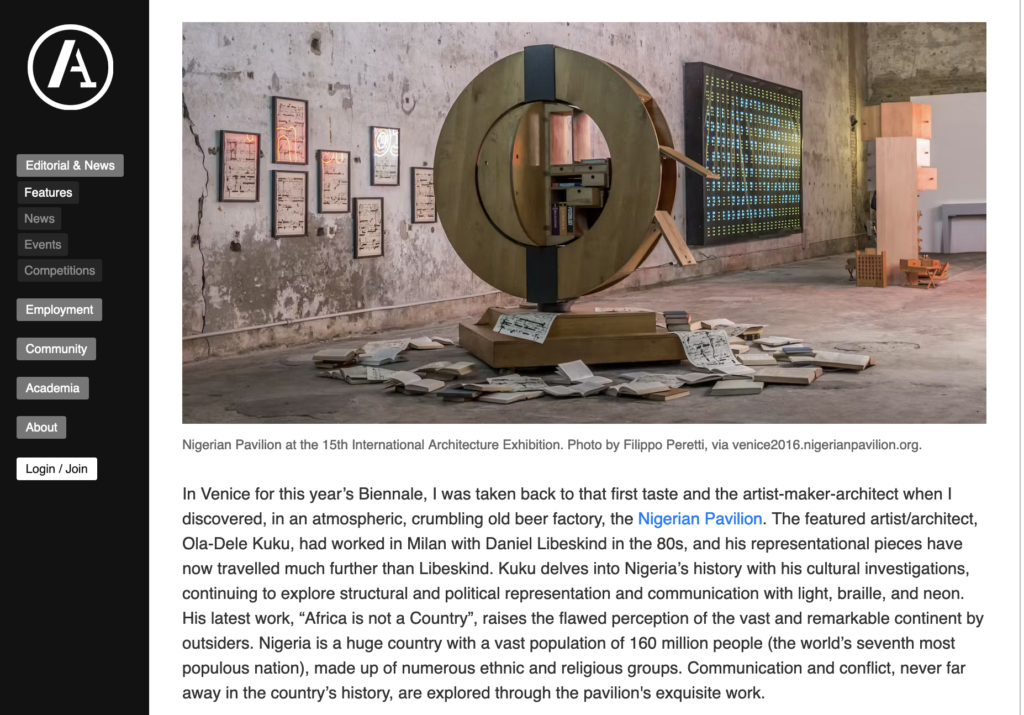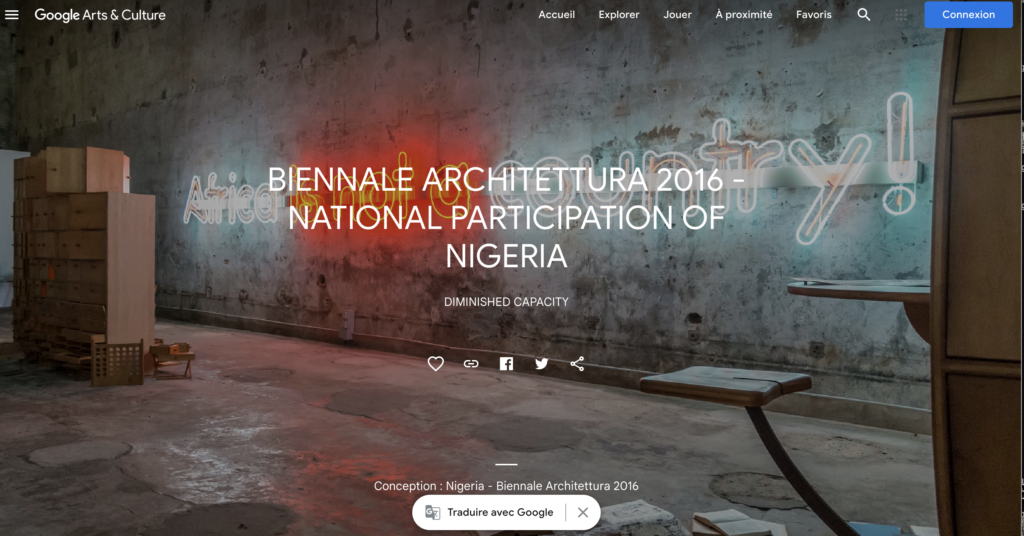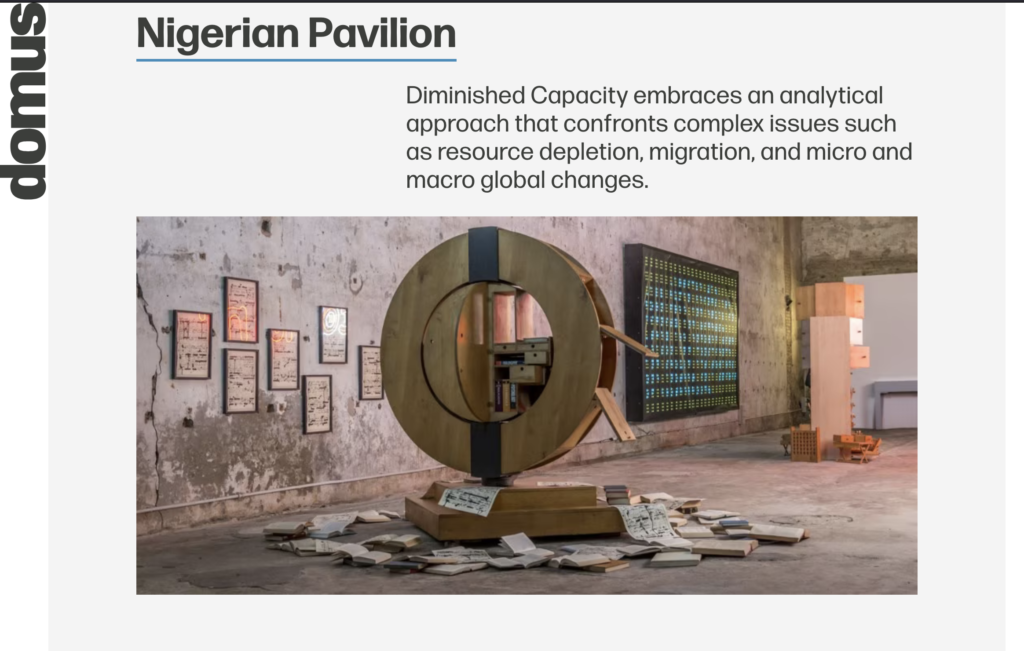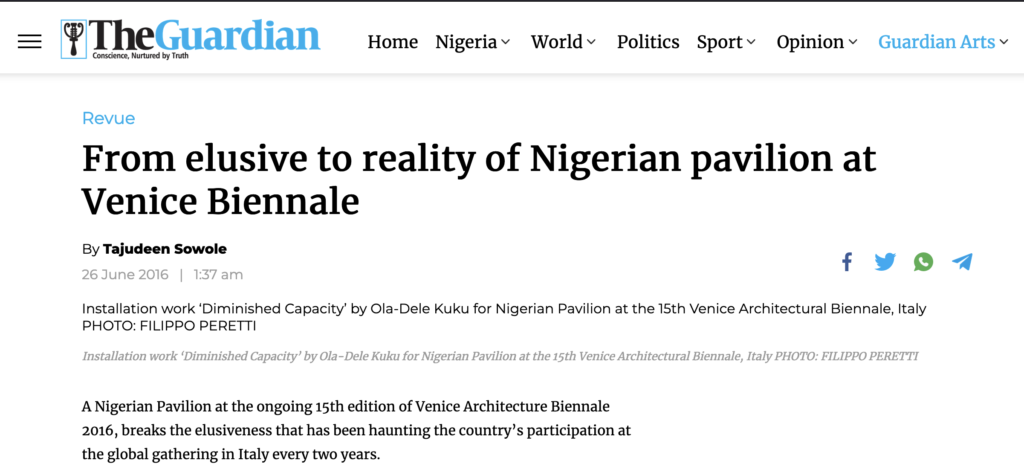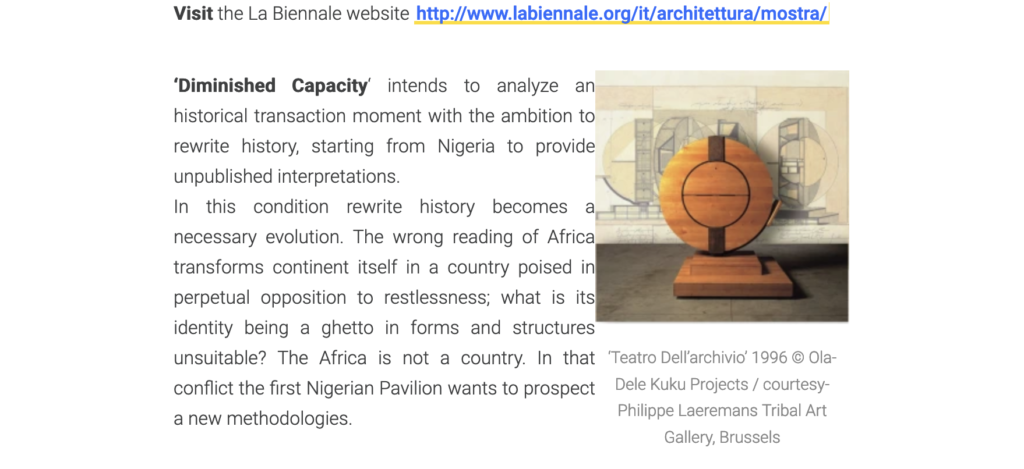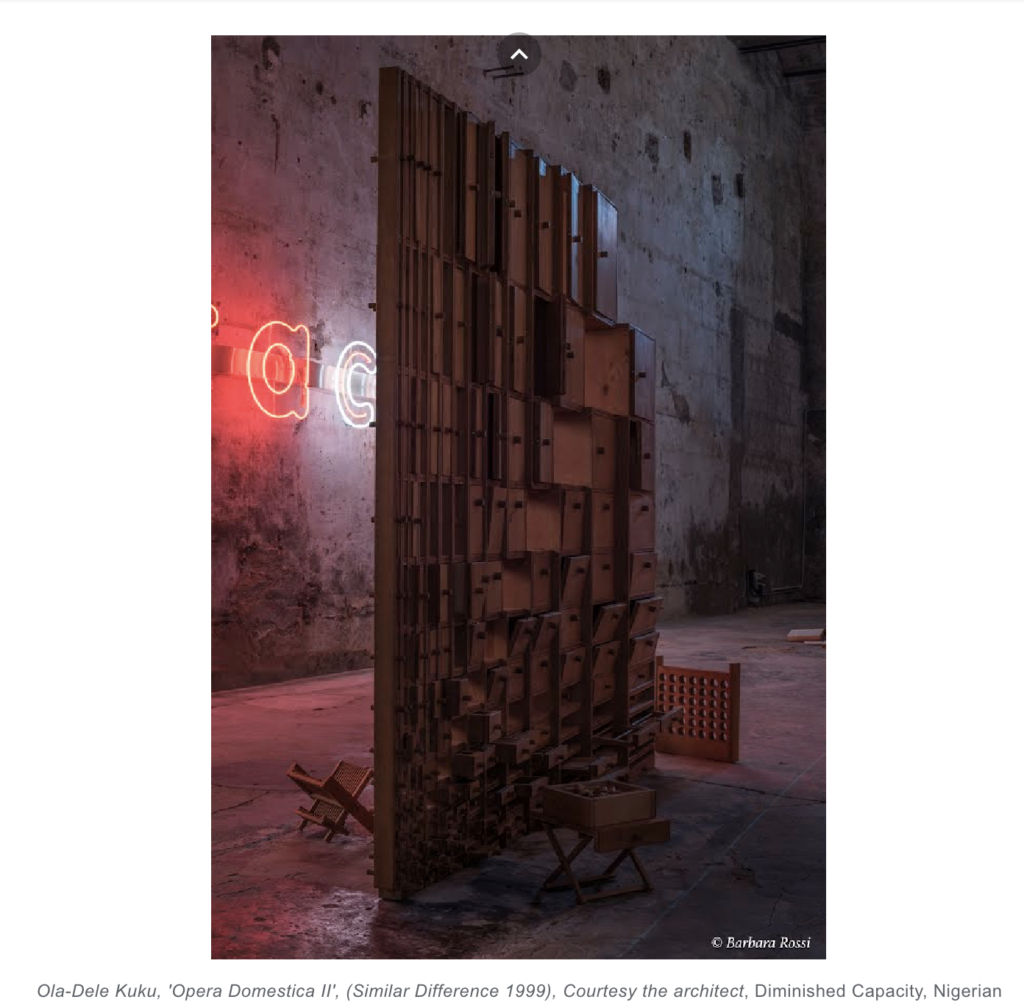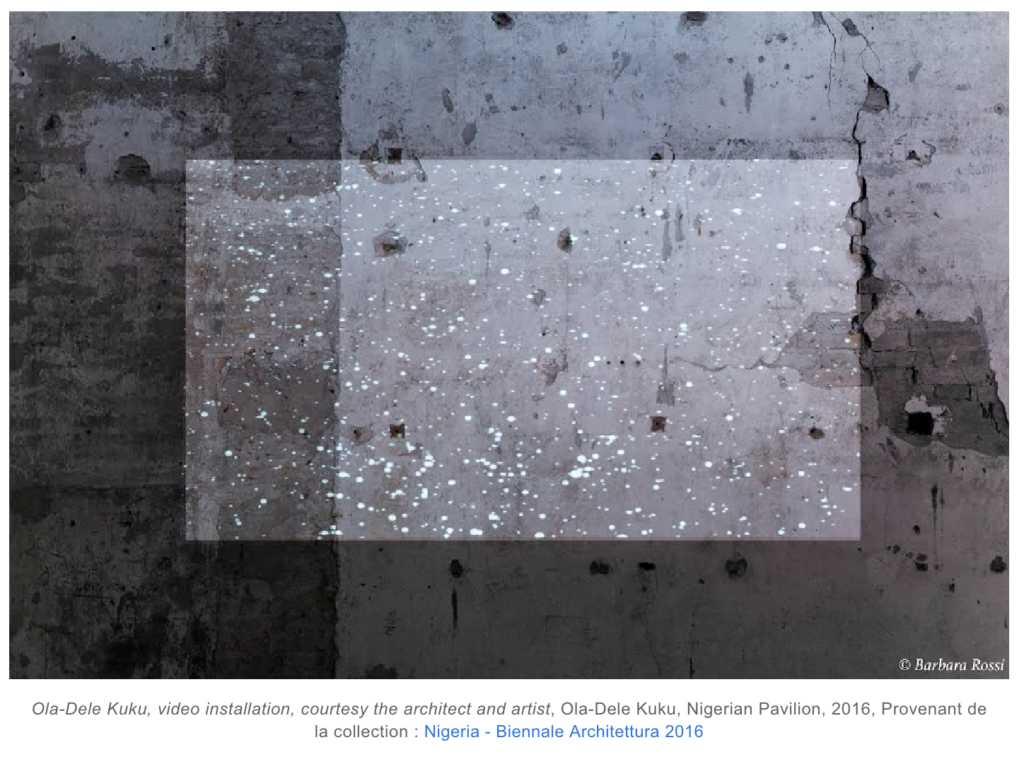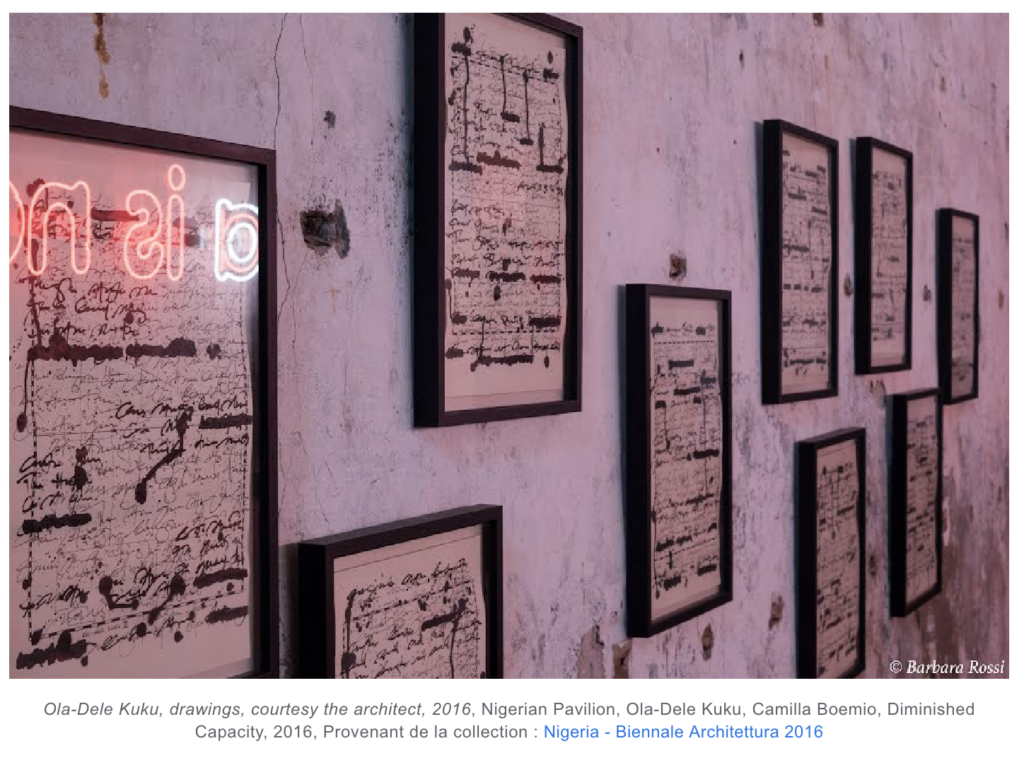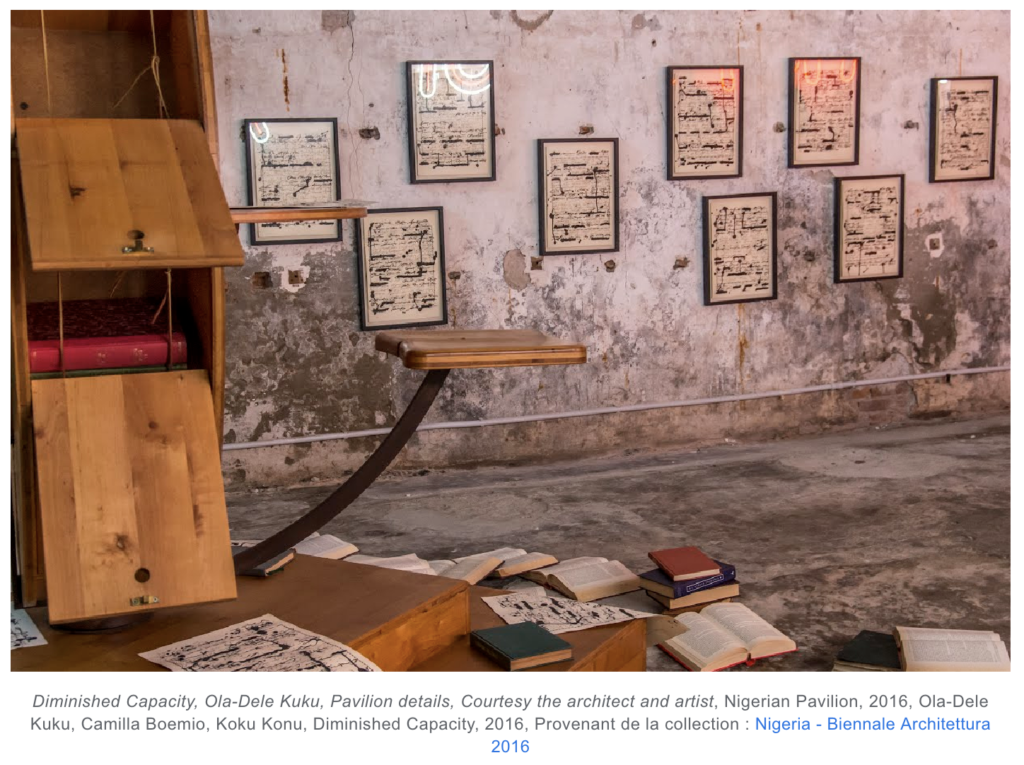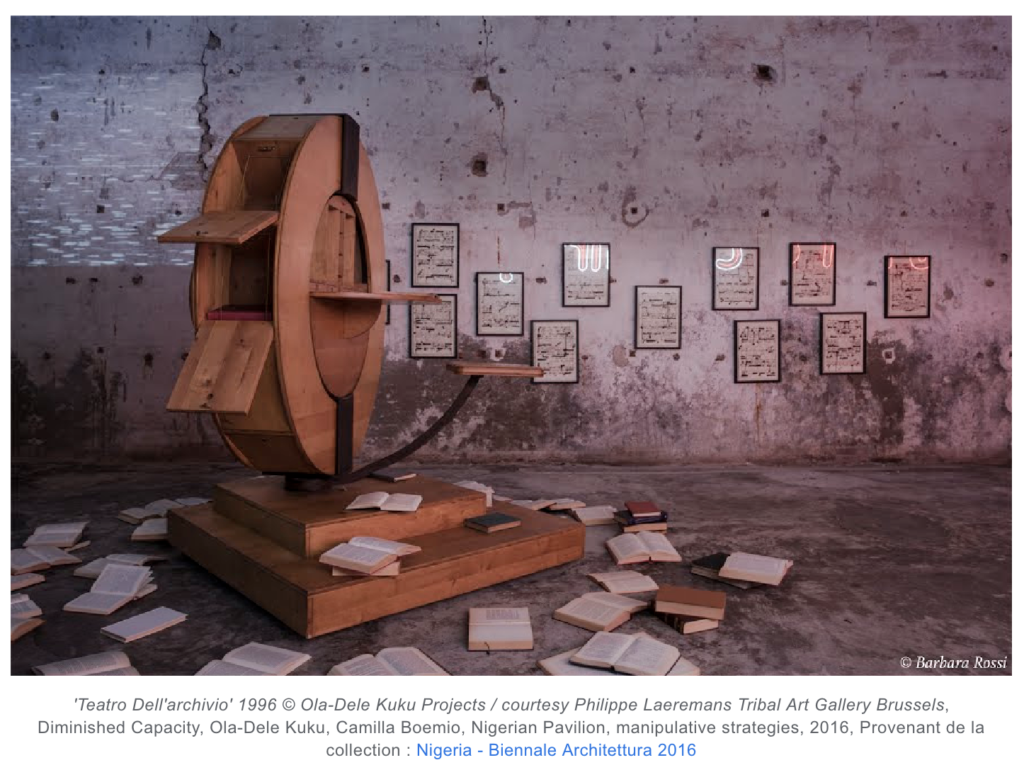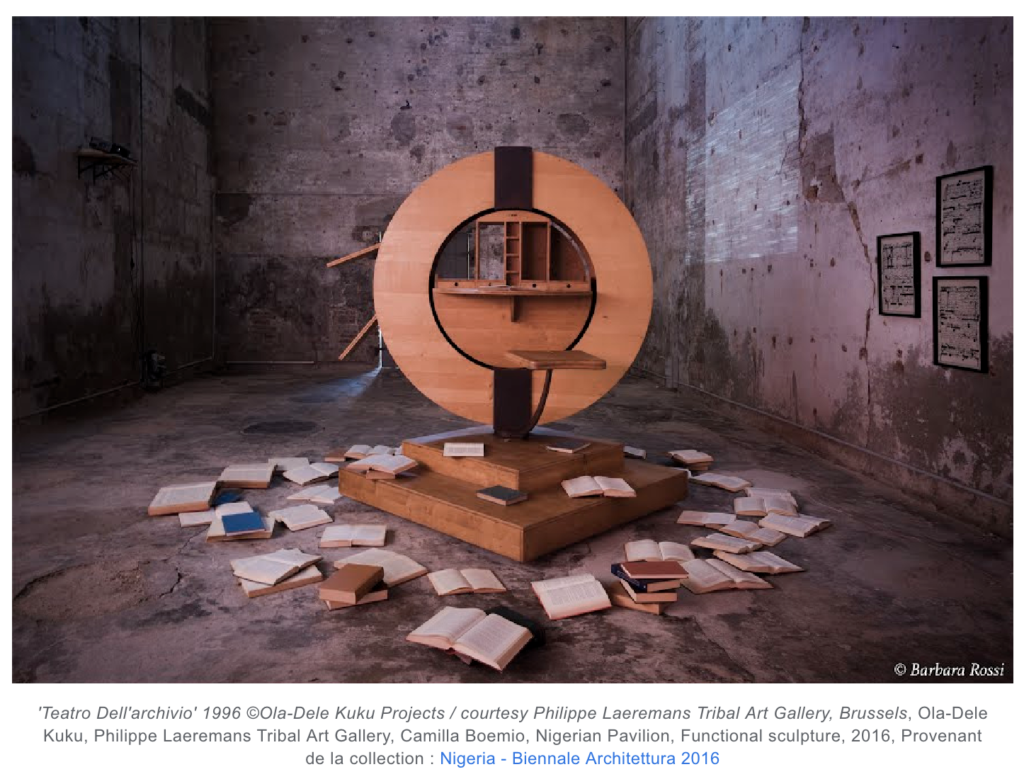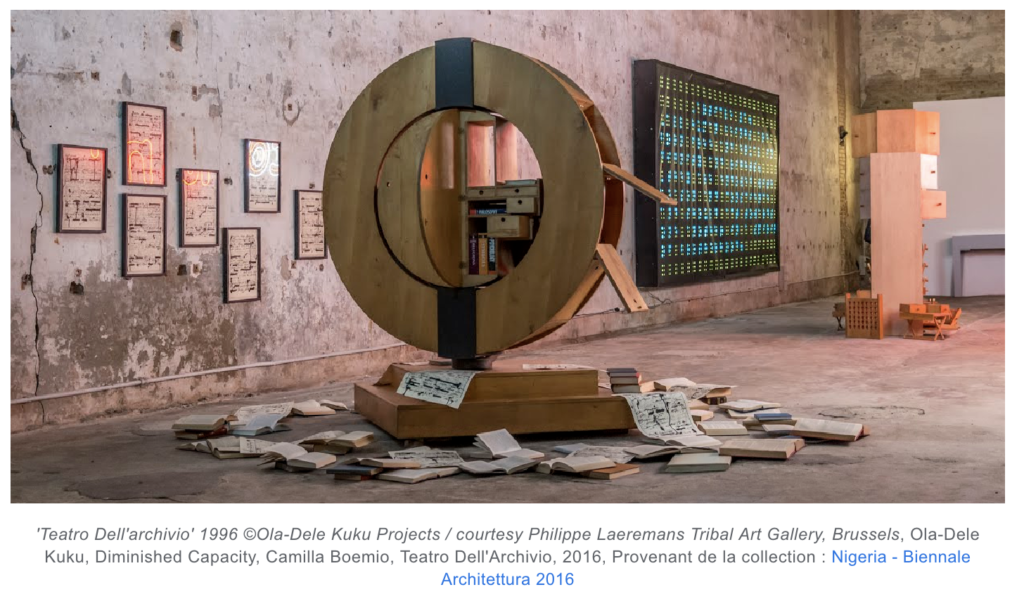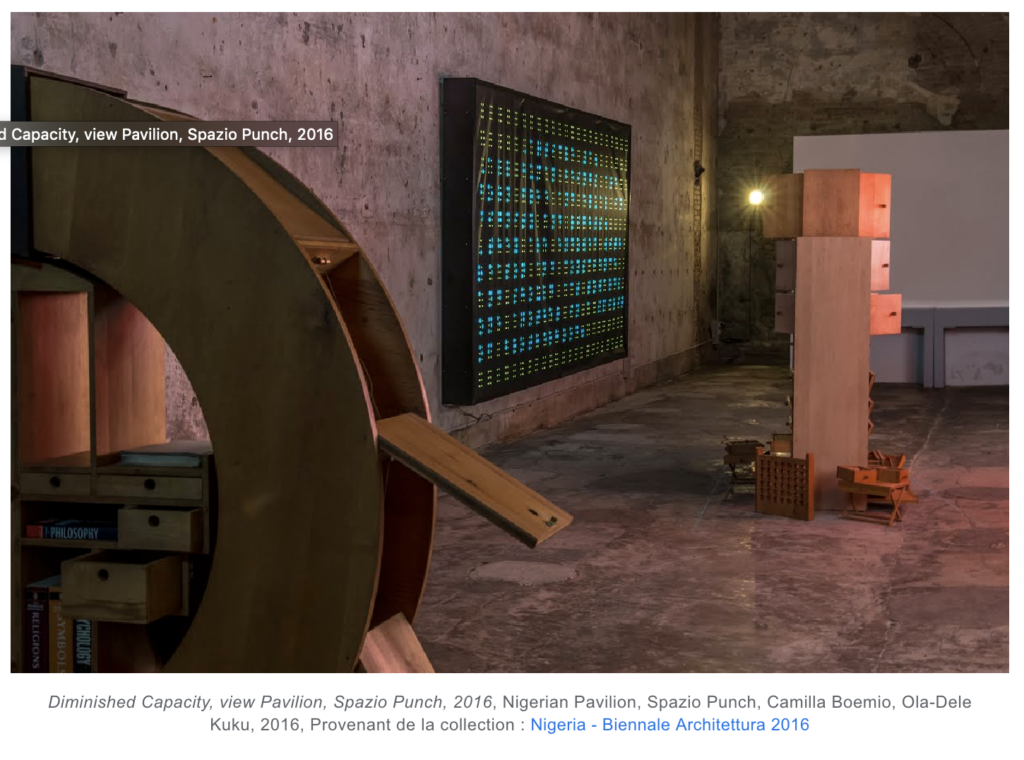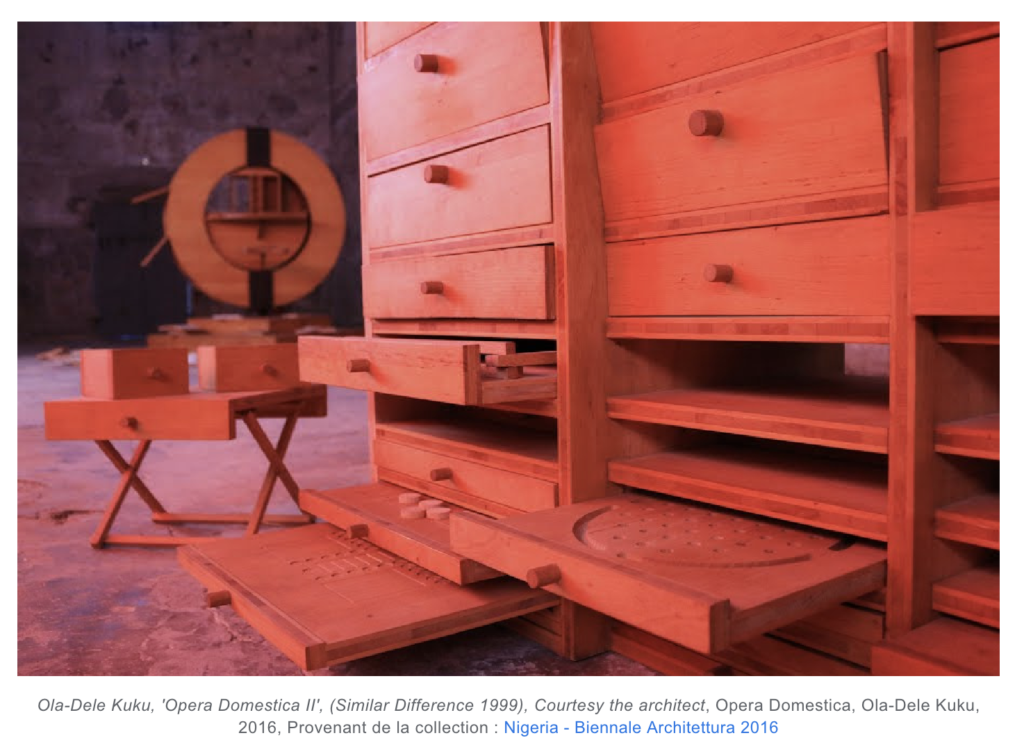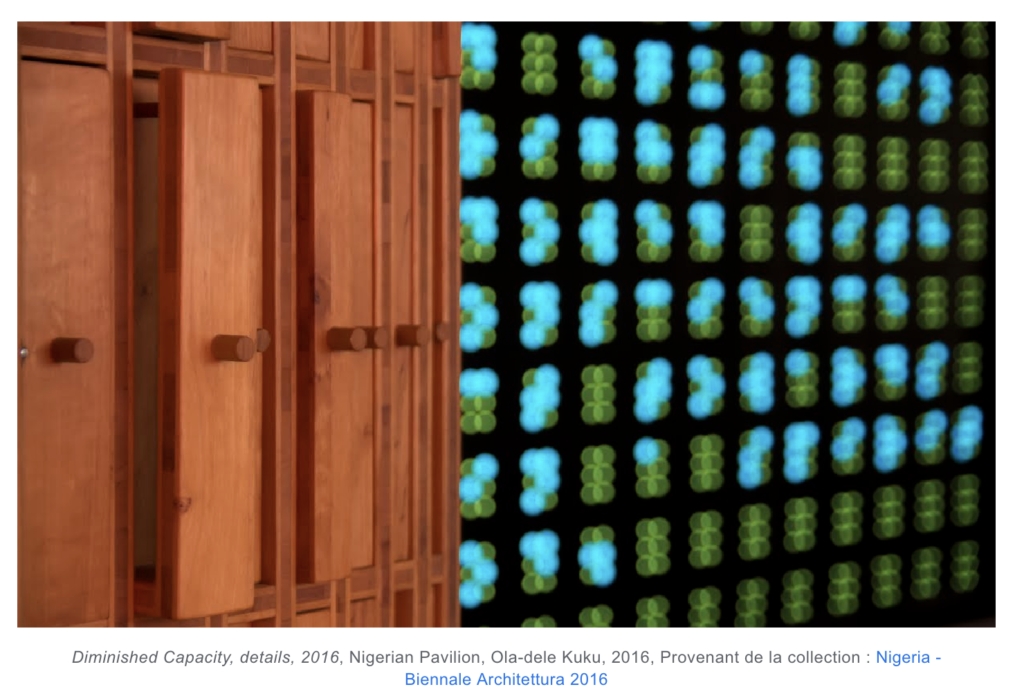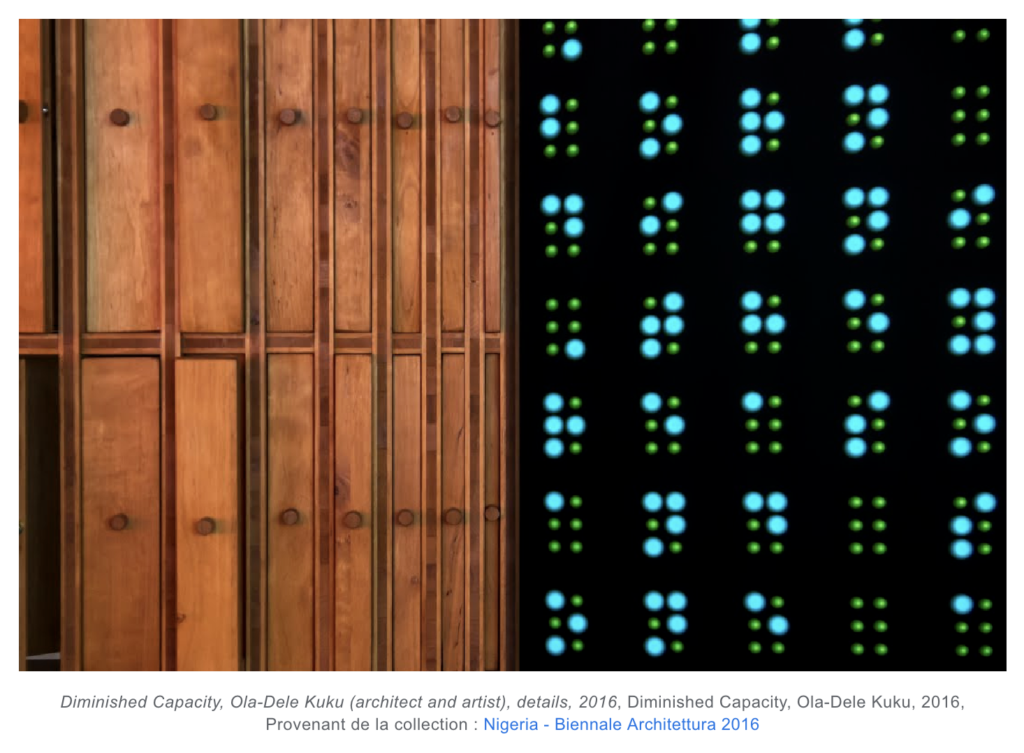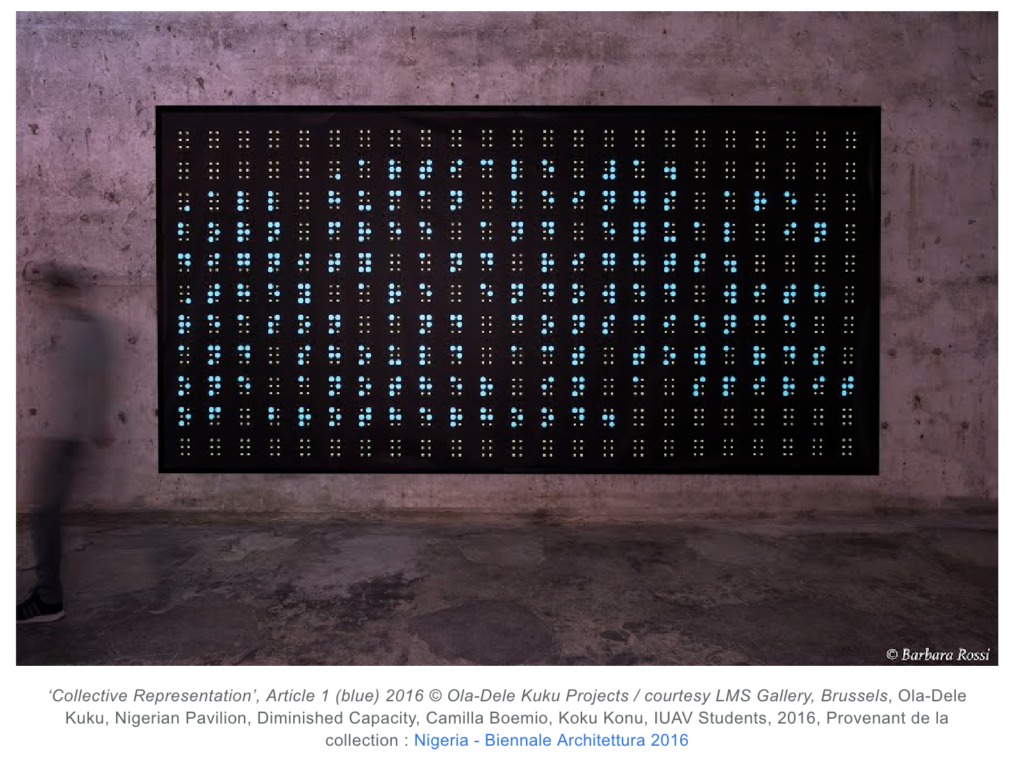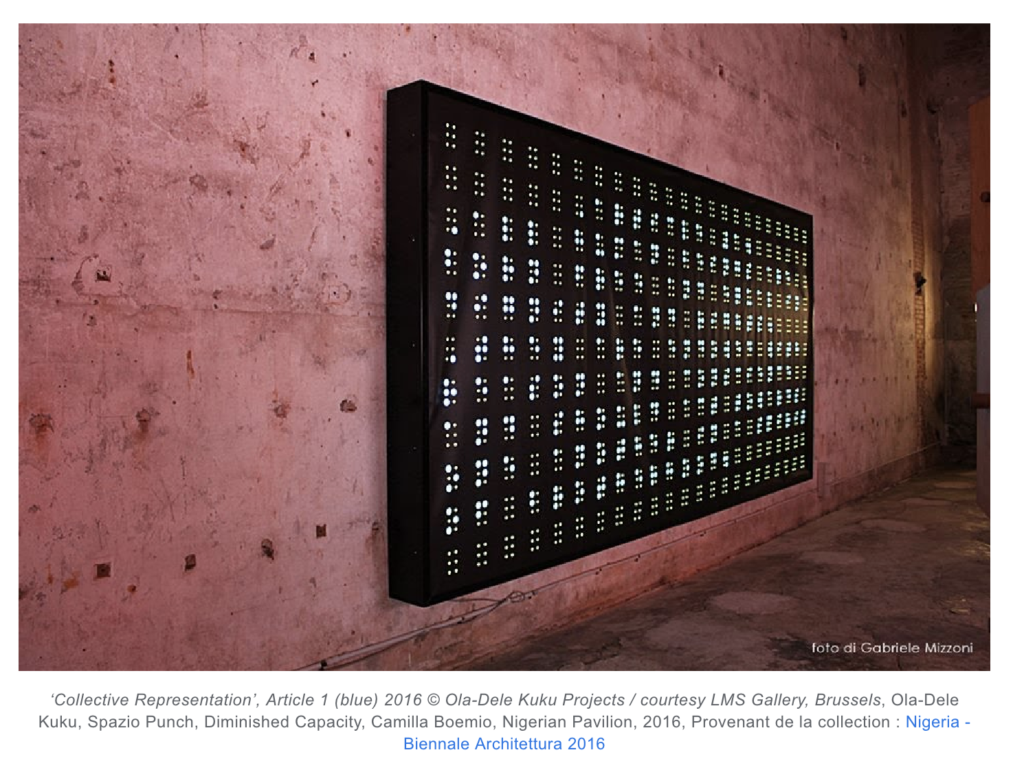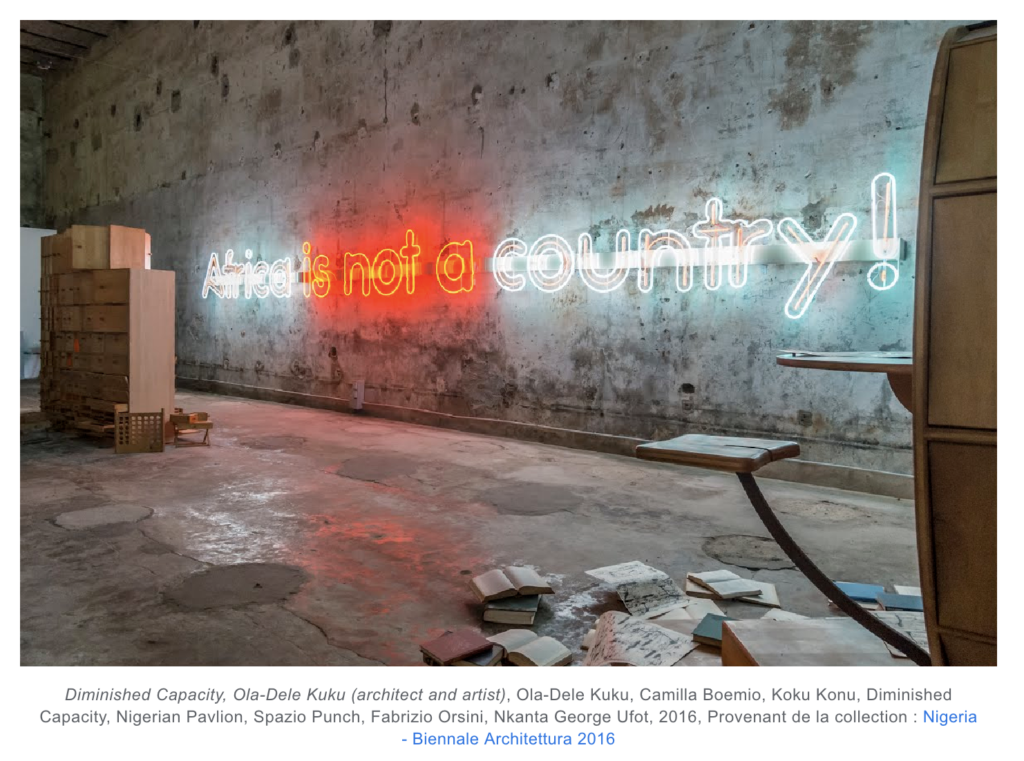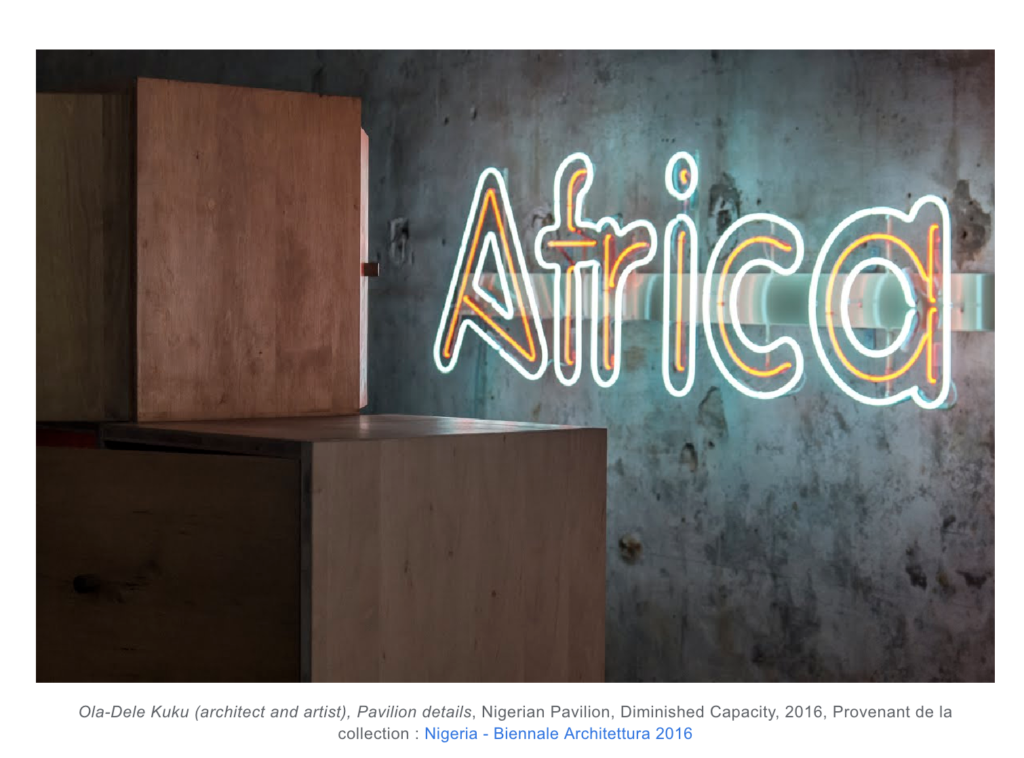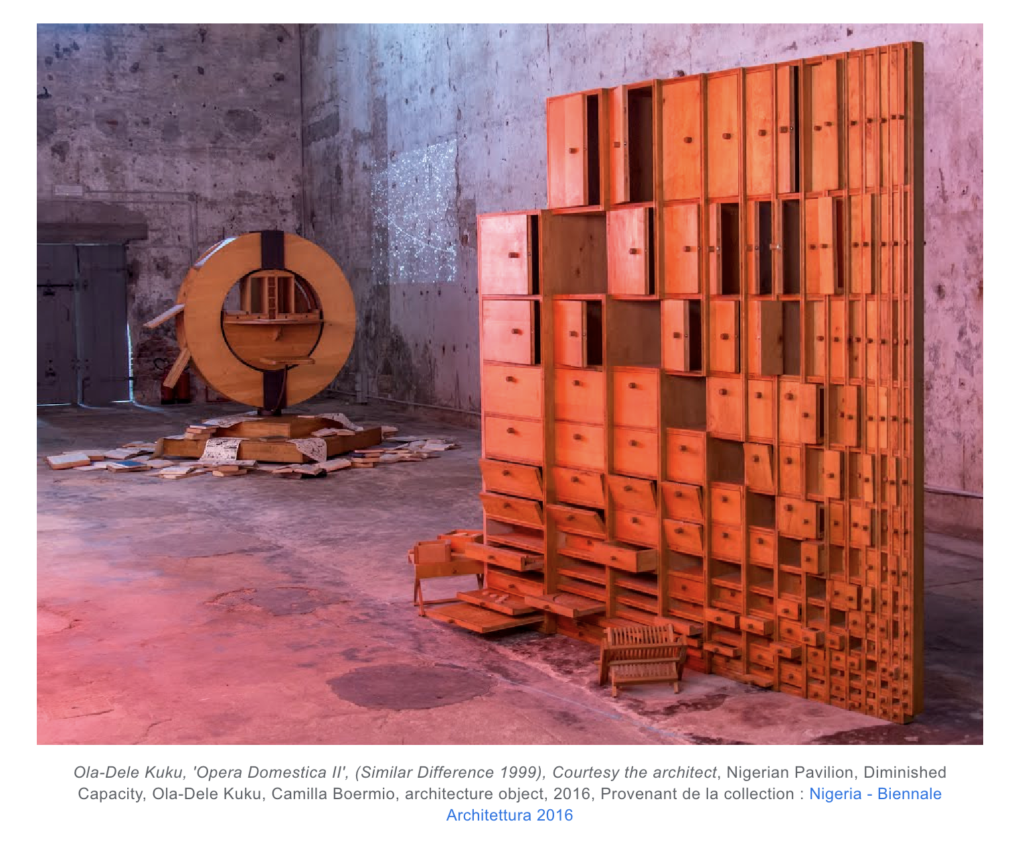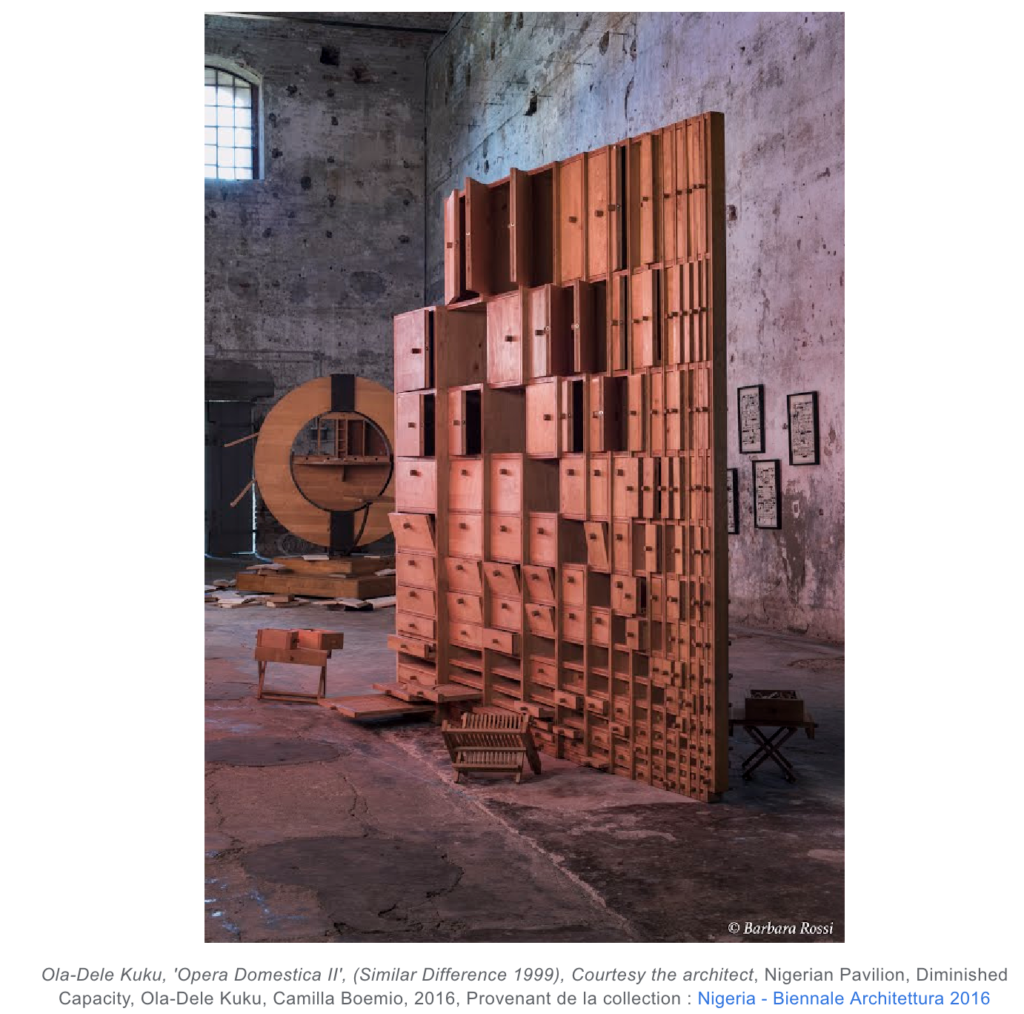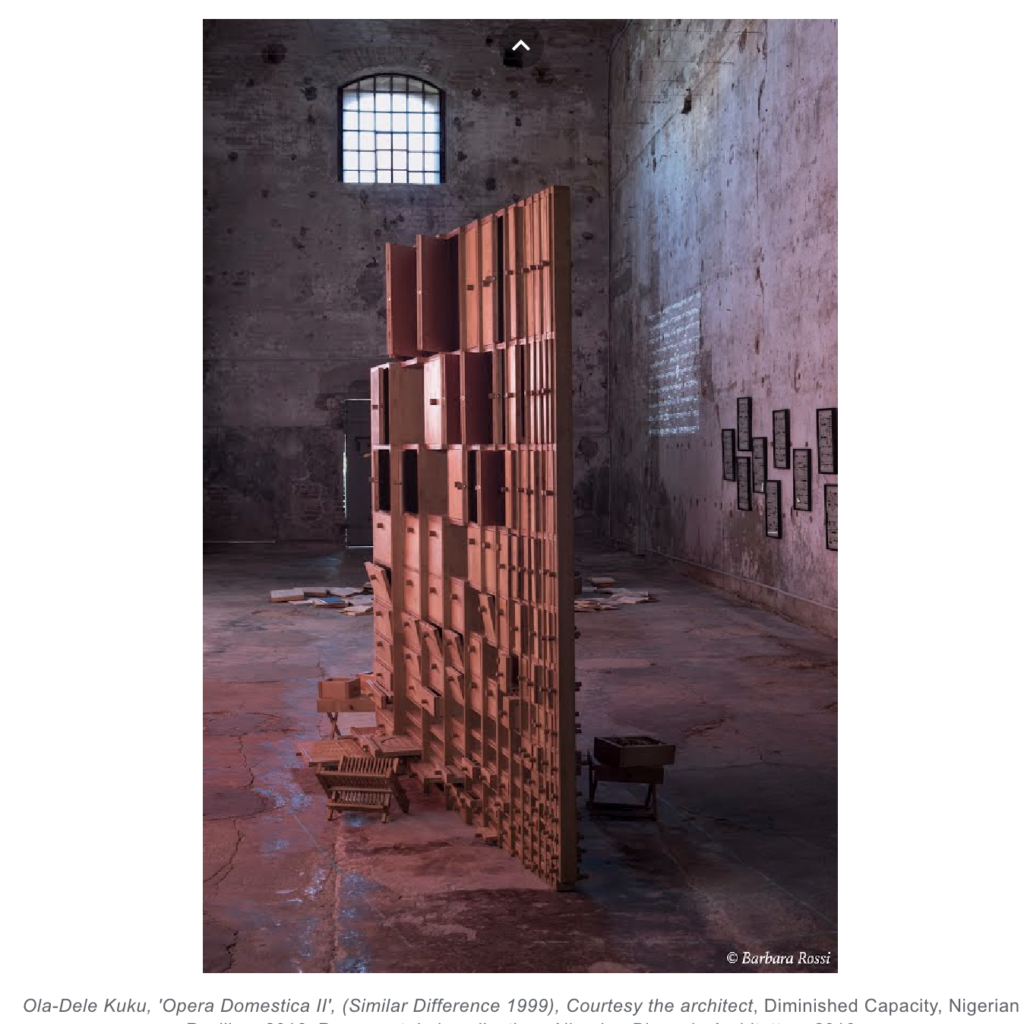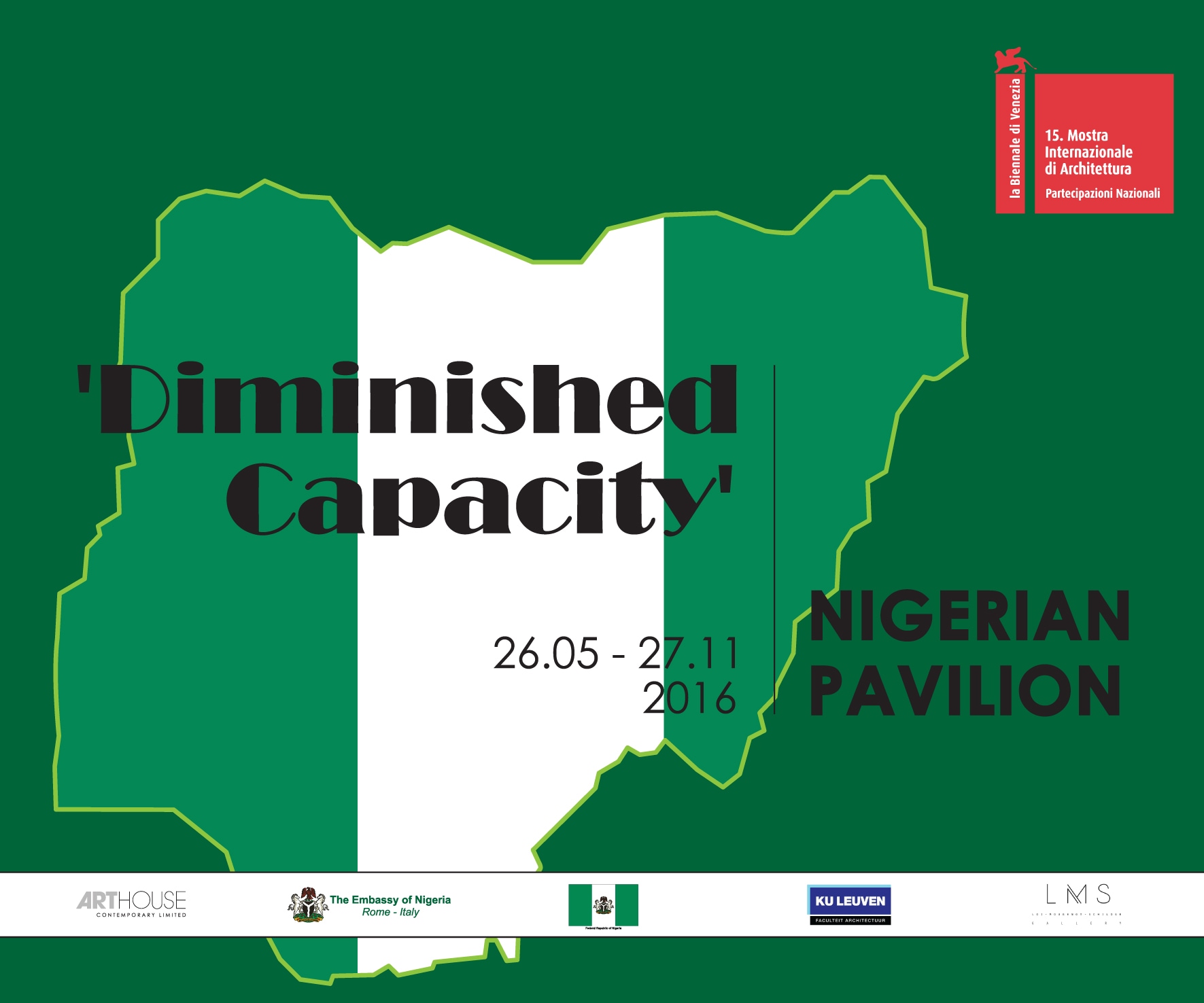
Nigerian Pavilion
15th International Architecture Exhibition la Biennale di Venezia
‘Diminished Capacity’
Diminished Capacity intends to analyze a historical transaction moment with the ambition to rewrite history, starting from Nigeria to provide unpublished interpretations. In this condition, to rewrite history becomes a necessary evolution. The wrong reading of Africa transforms the continent itself into a country poised in perpetual opposition to restlessness; what is its identity in forms and structures? The rhetoric of crisis suggests an apocalyptic scene where preventive measures and special interventions are required to ensure the survival of neoliberal forms of governance. Indeed, constant proclamations of crisis merely provide justification for political and economic reforms – reforms that would be otherwise unacceptable in a more empowered society. “Africa is not a country!” In that conflict, the first Nigerian Pavilion wants to prospect new methodologies.
Conflict is one of the recurrent themes in the work of Ola-Dele Kuku. The architect–artist sees that as one of the driving mechanisms in our world, and as a tool to set change in motion. “Conflict has played a crucial role since the dawn of creation, from the stories of the Big Bang to the paradise of Adam and Eve.”
Throughout his practice, Ola-Dele Kuku has consistently reshaped representation in a timely challenge. Working with drawing, installation, and objects, he has revisited the mainstays of architectural representational methods – plan, elevation, section – to inject unsettling slippages into their rigorous formalism. This new body of work fully embraces an analytical socio philosophical slant that confronts complex issues such as resource depletion and their management, migration, micro and macro global changes, and the diminished capacity of countries amplified by multiple applications of manipulative strategies.
Camilla Boemio (curator)
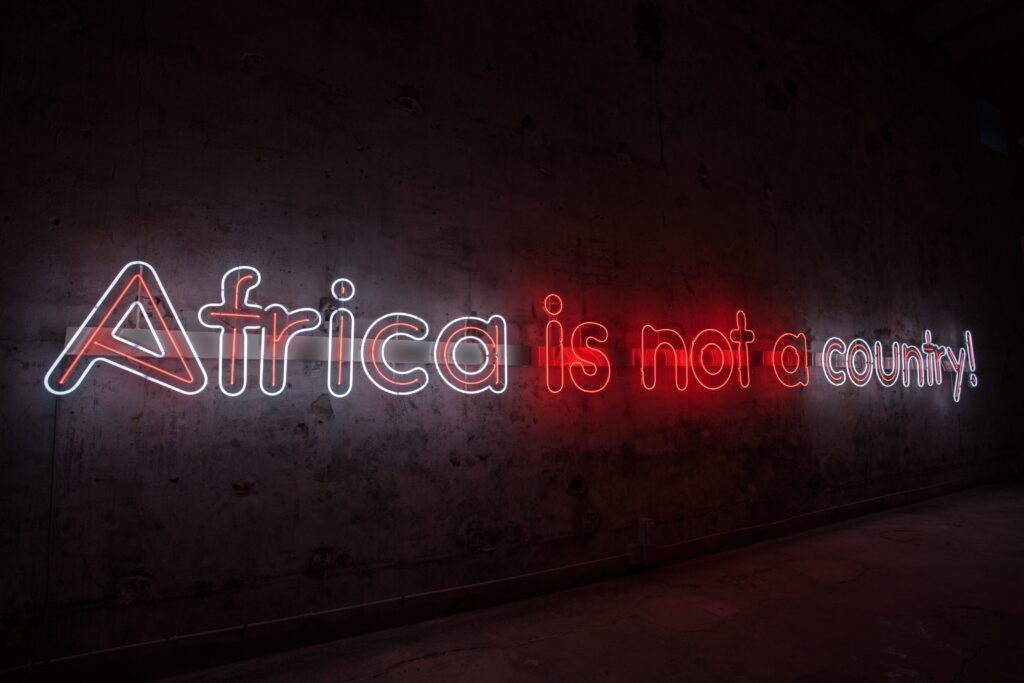
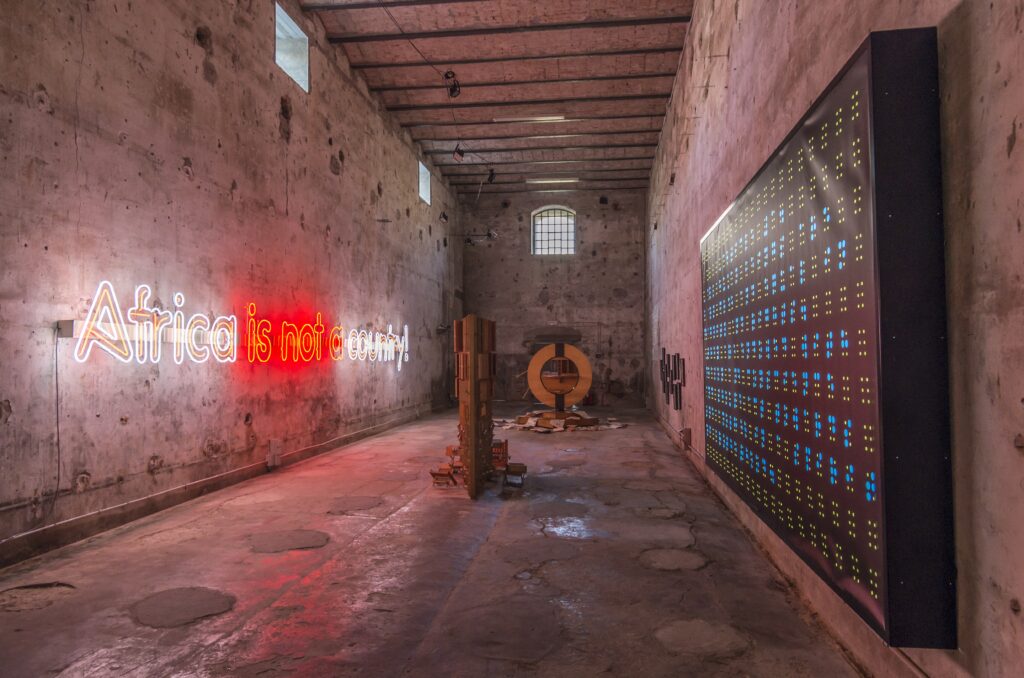

Venue: Spazio PUNCH – Giudecca 800/o, Venezia 30133, Italia.
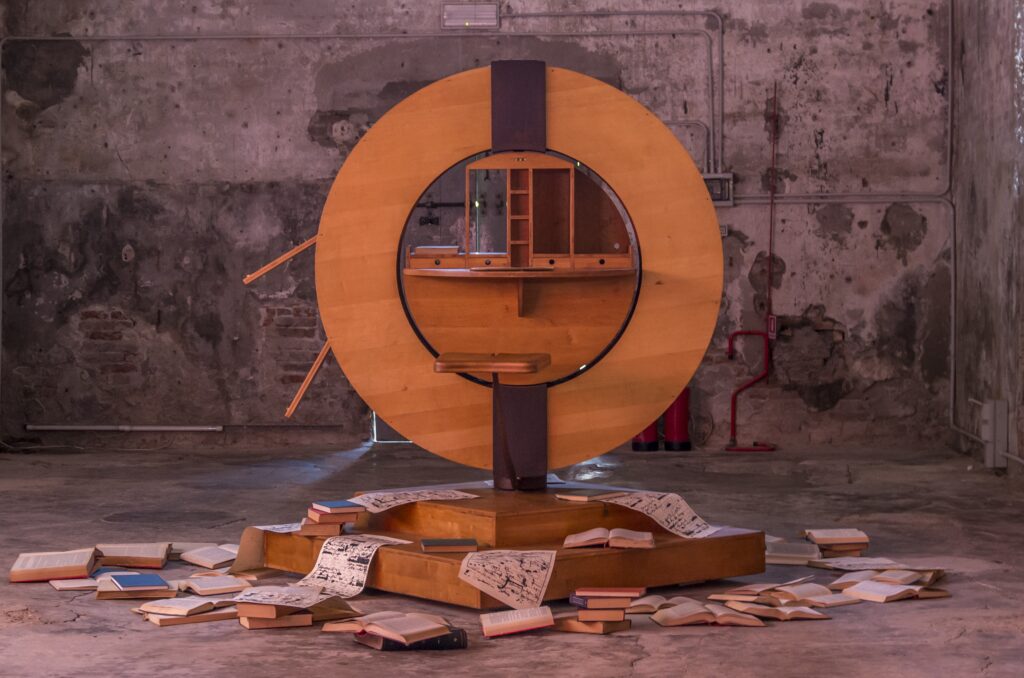
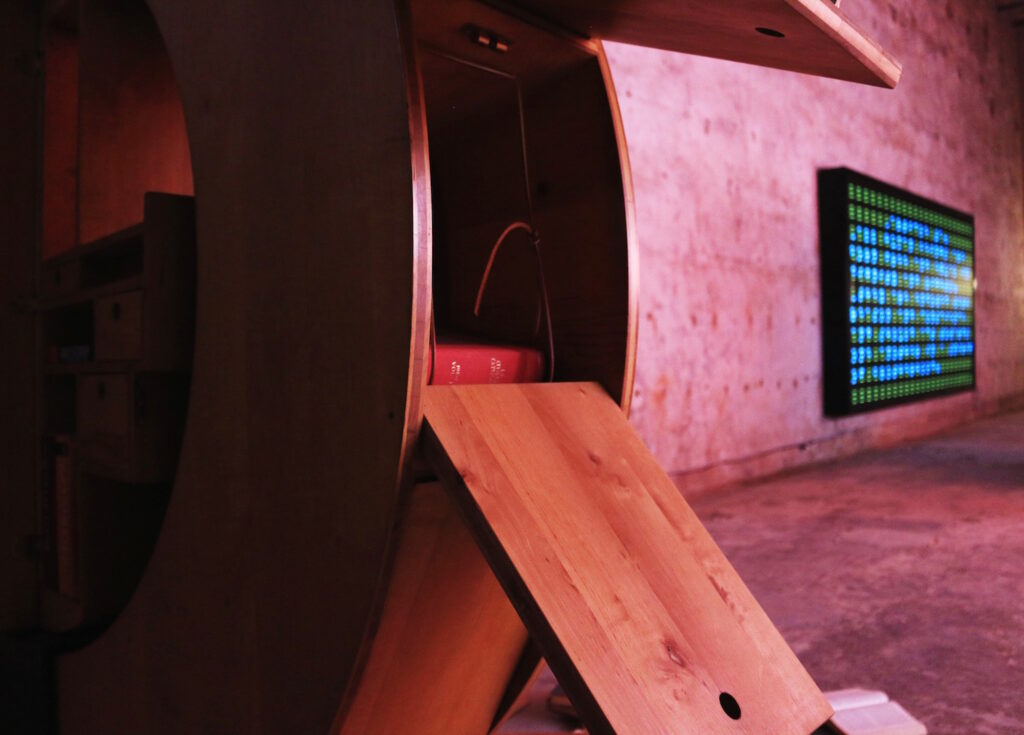
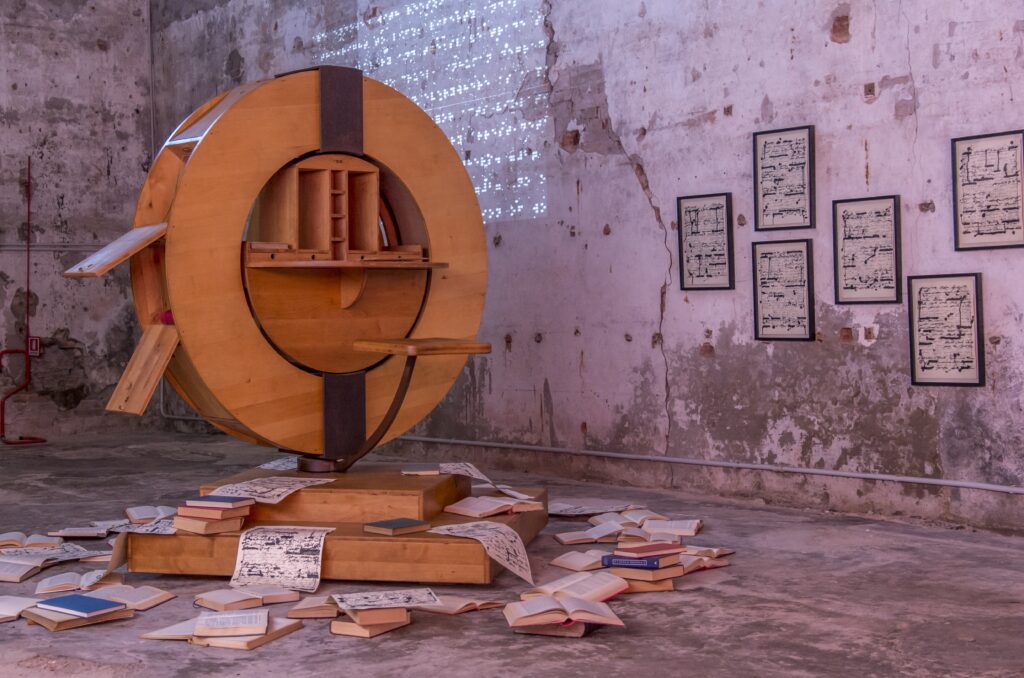
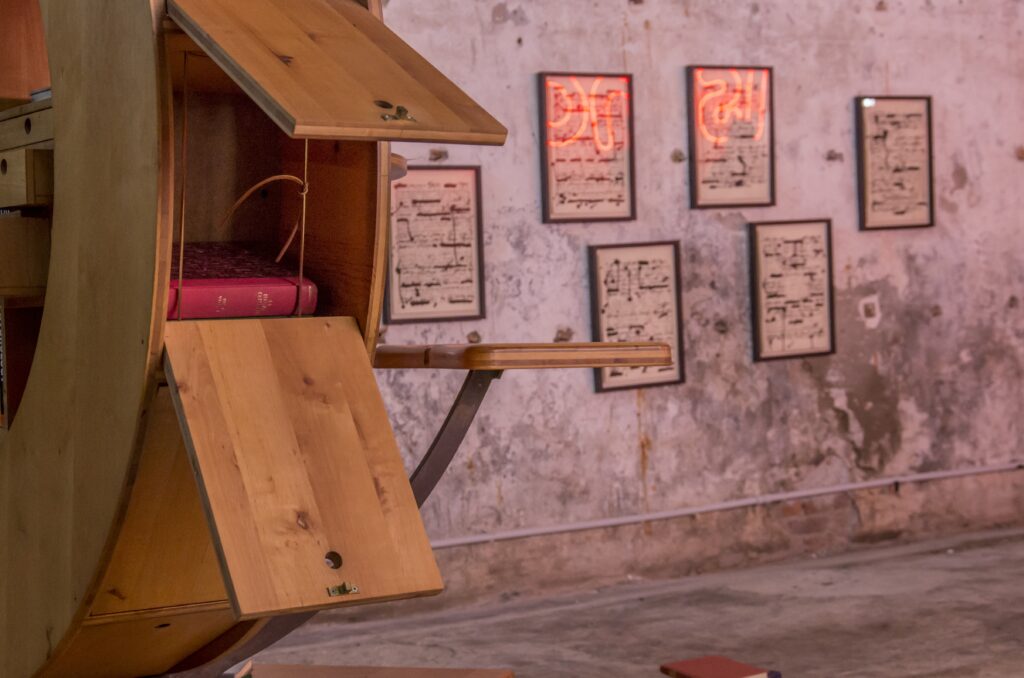
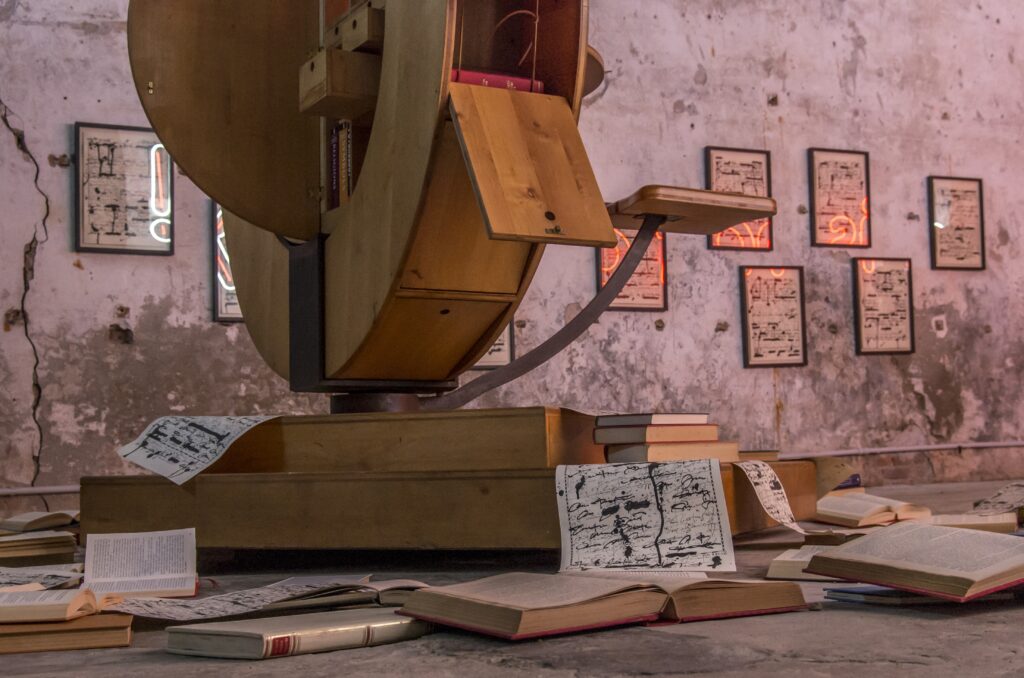
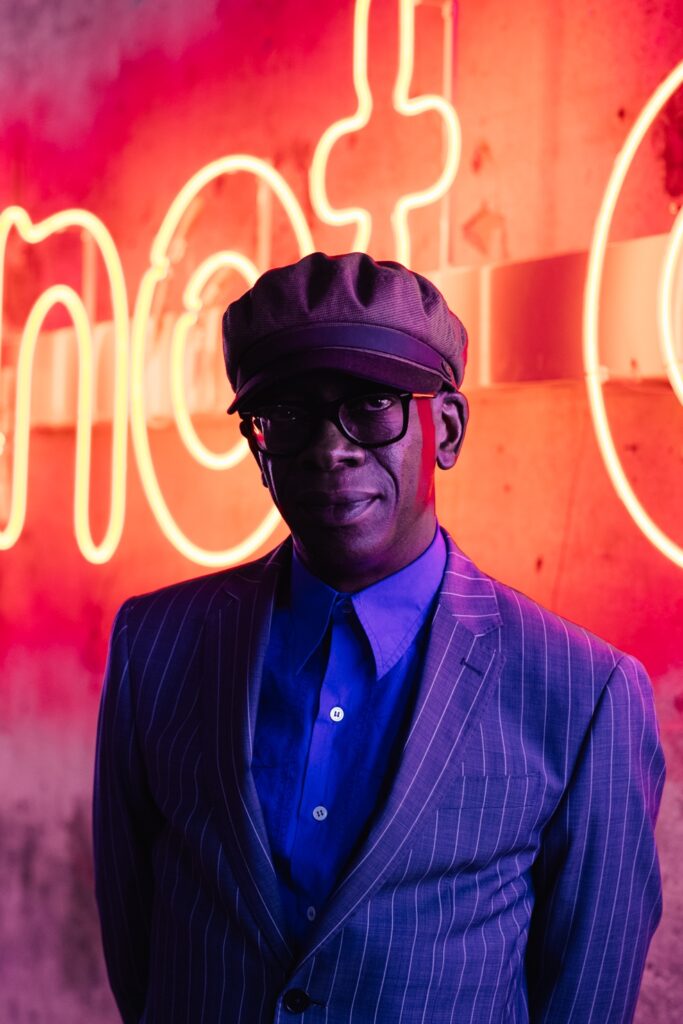
Ola-Dele Kuku:
architect of buildings of images and knowledge
Culture of conflict & conflict design : Interview with Kurt Vanbelleghem – curator / publisher contemporary art and design (7th Flanders design Triennial, Genk)
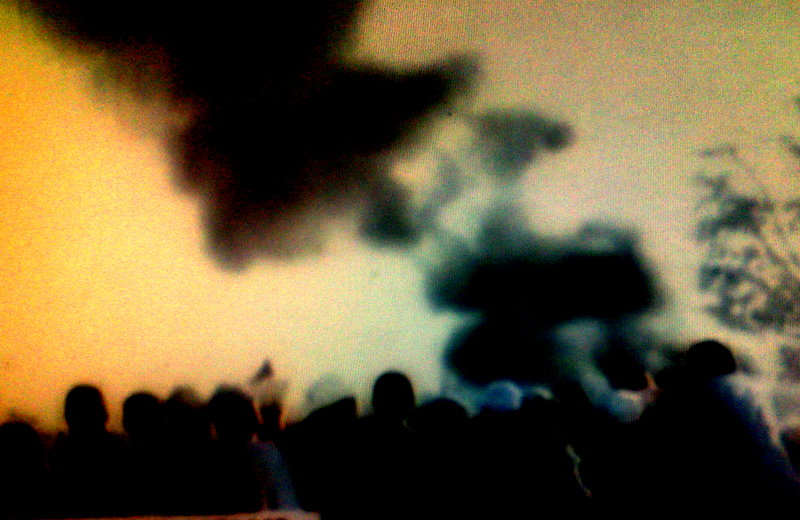
Ola-Dele Kuku’s roots are in Nigeria and he is currently living and working in Brussels. He studied architecture in California and Switzerland and has been teaching in Italy, the Netherlands and Belgium. Defining him as an architect is hardly accurate. You can additionally label him as a philosopher and an artist and a researcher but that still creates an incomplete picture of him. His most recent endeavours are dealing with design for conflict zones, on a practical and theoretical level. I had this interview with him one evening in his studio in Brussels, surrounded by remarkable objects, outcomes of previous research projects. The result is a wonderful conversation with one of the most intriguing personalities I ever met.
Kurt Vanbelleghem: You introduce yourself as an architect, because you studied architecture. At the same time, you are extremely critical towards the ongoing definitions of what architecture is and the tasks an architect has to perform. From your point of view, being an architect should be a transcending, intangible experience.
Ola-Dele Kuku: One thing I learned about architecture is that it is a continuous experience. You don’t go to school to study architecture with the assumption that when you graduate you will know architecture. Things get more complex, there is a transition, an evolution. Architecture is a subject of pure identity. Egyptians made pyramids; Greeks made columns, Romans made arches. Architecture today usually ends up being a building, occupied by people, different styles, different adaptations, but we are not forced to reinvent the situation that provokes architecture. The inspirational level and the spiritual aspects within the so-called philosophy of architecture and the driving force to represent the unknown or to capture the essence of the intangible is somehow fading due to or own socio-cultural evolution. The economy totally dominates our society; we don’t have space for the arts to dominate any more. When the gods were famous, the architects were calling the shots. Maybe present transformations in our society today will cause the architect to start thinking again. With the notion of conflict, disaster and destruction, we live in a very curious period; I want to see how architecture will reactivate itself as a kind of response to this.
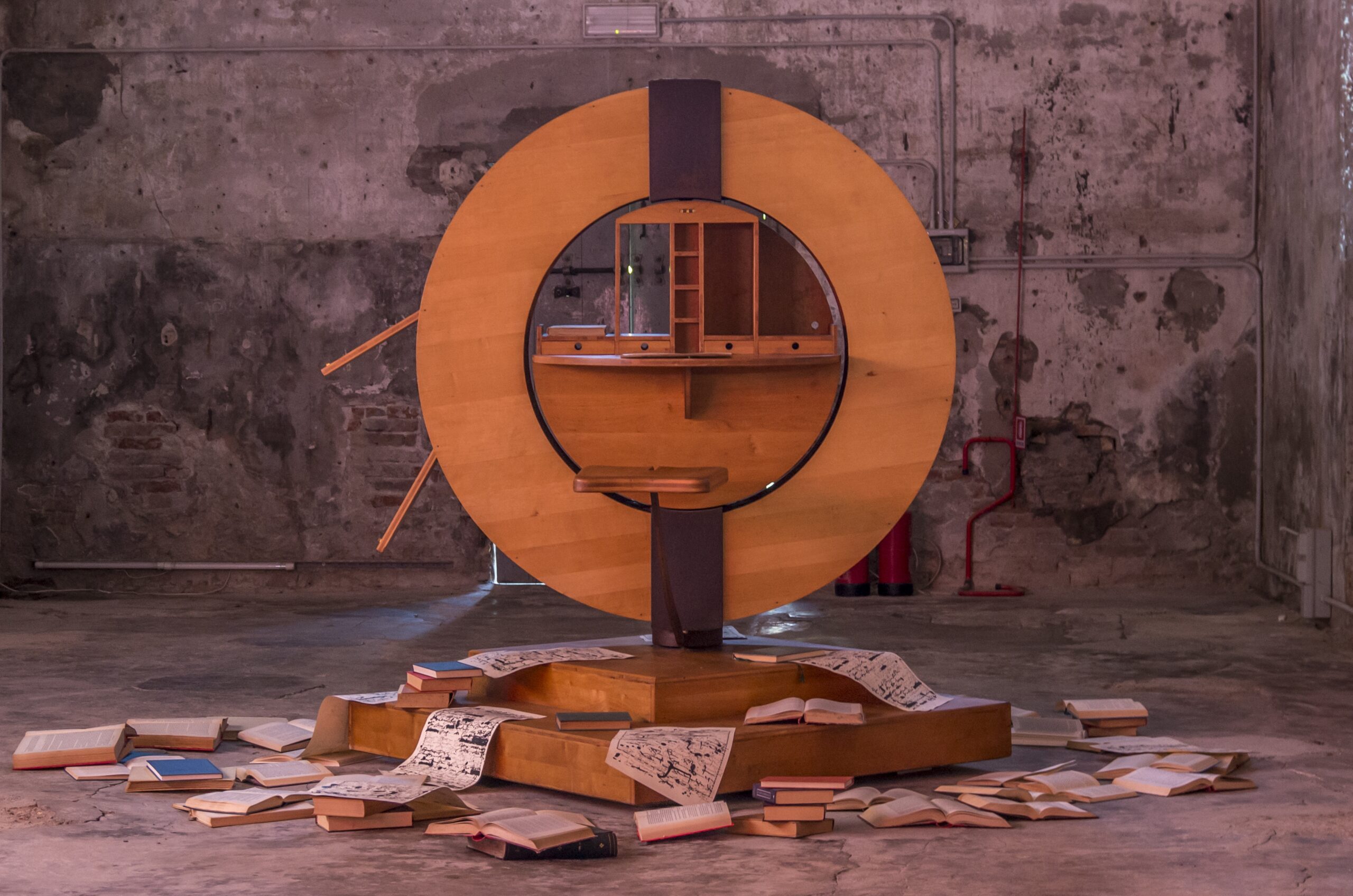
KVB: Architecture as a kind of philosophy-in-action?
ODK: We do live according to past definitions of living. We live in places that respond to our basic ‘domestic rituals’ principles. There is the living room, the bathroom, the bedroom, the dinning room and the cooking room. These are the definitions of a living space today, and an architect has nothing to do with that anymore. That is just planning. Architecture is detached from the human essence. City planning is a response to social need and social organisation. You live your routines, and there is a lack of affiliation with the living space today. Our existence within the dwelling space is usually characterized by series of ‘domestic rituals’ which are performed repetitively as consistent routines. The accommodation of these ‘domestic rituals’ forms the basis for the division and composition of the dwelling space. The symbolic representations of these actions are made evident by the specific objects that define the particular events which can be accommodated, within the space. Therefore, the evolution of the dwelling space is quite redundant in comparison to socio-cultural transformation. There are additional requirements to the basic composition in order to accommodate our new tendencies thereby introducing new spaces such as the tranquillity room, reflection room, recovery room, (and so on), with new representational designed objects and environment to symbolize the specific domestic rituals.


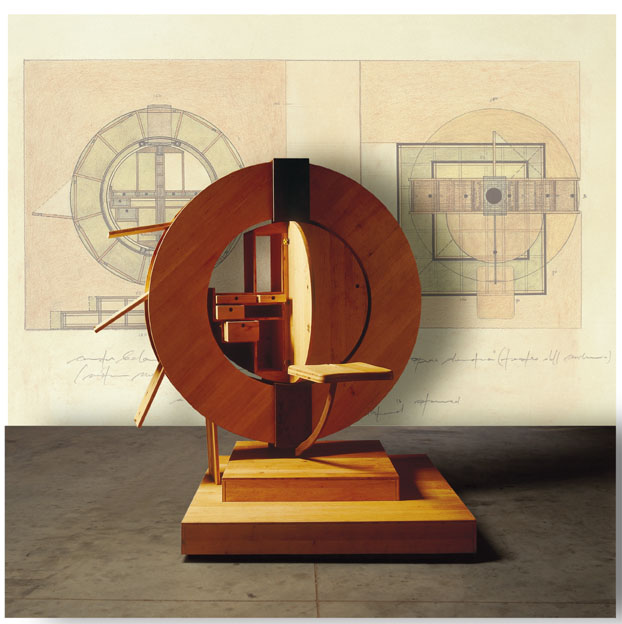

KVB: Mystic elements play an important element in your thinking.
ODK: Yes, because our lives are based on very sophisticated and consistent routines.
The cosmic system is subjected to a phenomenal mechanism by which natural laws are acknowledged in the realm of an order, which is acutely opposed to change or rearrangement.
The origin of existence is viewed as a phenomenon, which began out of a point or nothing. A point in this case refers to the absolute no dimension having, no height, length or width and this impossible to illustrate by physical or material means.
We can immediately conclude that this apparent no cause event out of space and time could be termed as a meaningless or non-objective situation, which by definition, is a miracle. In the physical state, there can be no event without a cause and existence at any moment expresses a notion of continuity rather than state or expression. These progressive successions are coeval with universal entities existing in all directions, past present, future and the elsewhere. These reciprocal components are of mutually interlocking relations of interdependence.
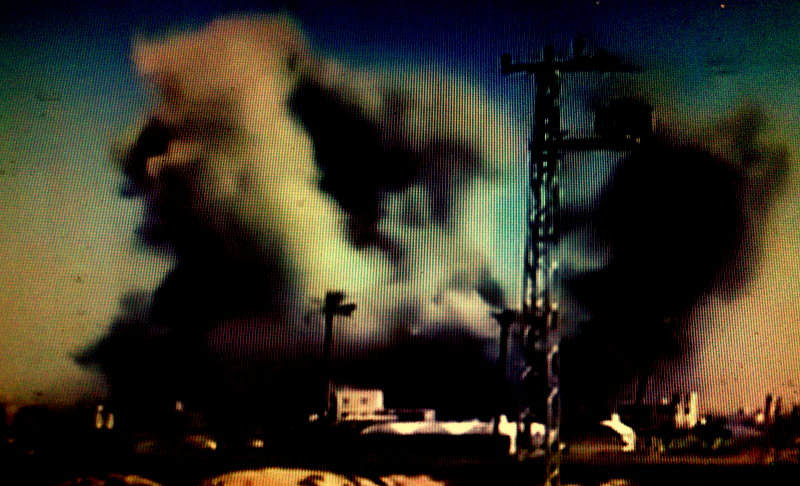
What is so mystique about this repetition is the chance that within every repetition, there are infinite possibilities and the ‘certainty of change’. Reoccurrence of events and experience form the basis for the interpretative supposition in the apprehension of the unfamiliar. Experienced events deduce a structural composition of recollections and awareness, which facilitates the hypothesis of comprehension for particular instances. That contradicts also the fact that difference produce possibilities. We are subjected to all the intangible phenomenal complexities such as the gods, time, symmetry, gravity, numbers, death and the mind. These factors cannot be located as they are non-material and non-physical, thereby existing as in-existing and present. They can also be understood as the fundamental forces that govern. As an architect, I am fascinated by the ‘composition of structure’. Force, is an integral part of structure and the universal composition consists of the visible and invisible.
In order for anything to be kept in place, there must be force acting on it, just like the force of gravity keeps us to the planet and the force of symmetry holds us together. Hence, we all exist by force.
The mind, however, dwells within the physicality of being – as an attribute, which serves as a vital link between the physical world and causes from the natural universe. A junction between here and there where thoughts and dreams are composed, the mind can reason and acquire knowledge contrary to tangible practicalities and beyond what is superficially apparent. This property of the mind could be ascribed to the manifestation of creativity and intellect.
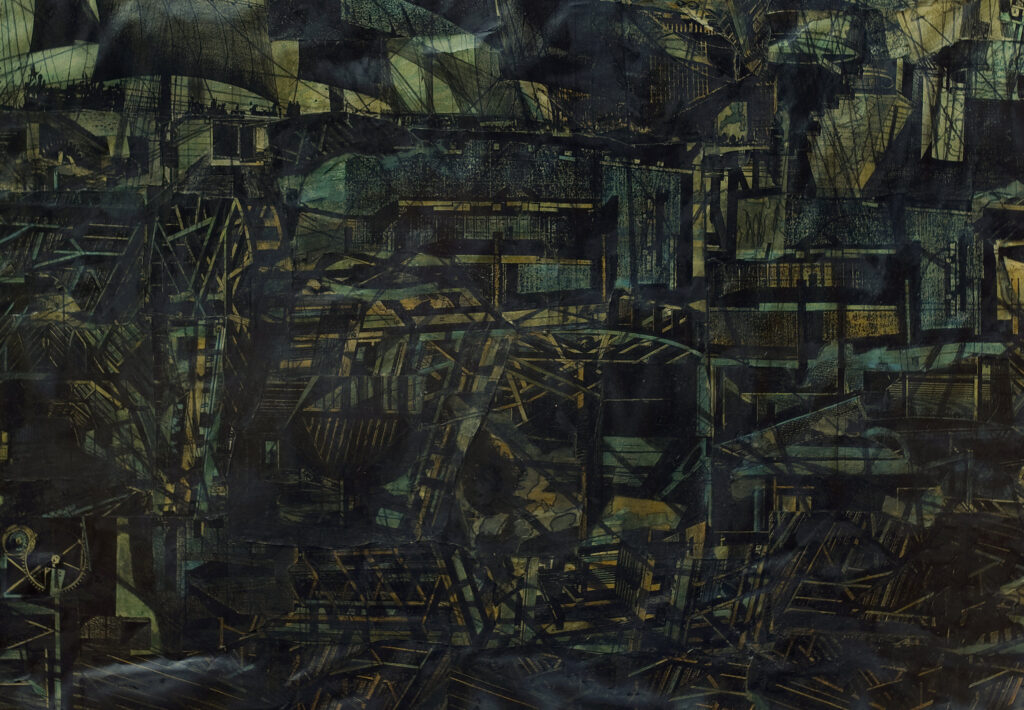
KVB: Historical visionary architects like Piranesi, Boullée or Ledoux had a keen interest in design that provides for an emblematic, supposedly ideal environment. Your involvement with architecture of inexistent structures shows a lot of similarities to their approach. Just as them, you also mainly use conceptual modes of representation, like teaching, drawings and essays.
ODK: There is a misconception between imagination and perception, they are not the same. Perception of an image is not necessarily consensus with the mental course of imagination.
Image perception tends towards a mental reproduction of previous sensory experiences relative to determined classifications.
An image is not confined to visual interpretation as it also represents variable connotations of perception such as attitude, impression and audible sensation, which could materialise as non-visible impulsive events.
One can imagine the earth spinning around the sun, but one can not see a whole aeroplane if it stands in front of him. With imagination, scale is an integrated value, whereas with perception, one is confronted with scale. The imaginative side of perception is what gives an overview. Those architects prefer to have an overview of things, which means, the reference to scale becomes very abstract. In philosophical doctrine, imagination or psychological perception forms the foundation for interpretation, knowledge and understanding. Imaginative thoughts remain primarily a temporal mental event of consciousness and physicality as an attribute of a conceivable creative mechanism preceding an experience.
For me there is a fascination about thought itself, being the sensation that precedes an experience, thereby transmitting the imagination into reality with respect to scale. The creation mechanism bounds what is being done within our physicality and scale in space and time in order for what is made to be conceivable.
I believe that the greatest human achievement still remains the discovery and use of numbers. As a subject of universal validity, numbers introduce meaning to the ineffable abstractions of the universe through representations and objective distinctions. We can introduce scale, we can not perceive scale. If I say 600 litres, you need to think of a form before you can think of these 600 litres. You need an image as a reference. We always have a bias conclusion of our perception. That’s our impediment also with space and with time. We need a clock to guide us. Drawings and imaginative thinking helps to be conscious of our lack of this dimensional aspect of being. Therefore we are also seeing things as we perceive things. The consciousness to scale is through vision. The first drawings introducing perspective was a major theme, if things do not get smaller visually, we won’t have a perception for depth.
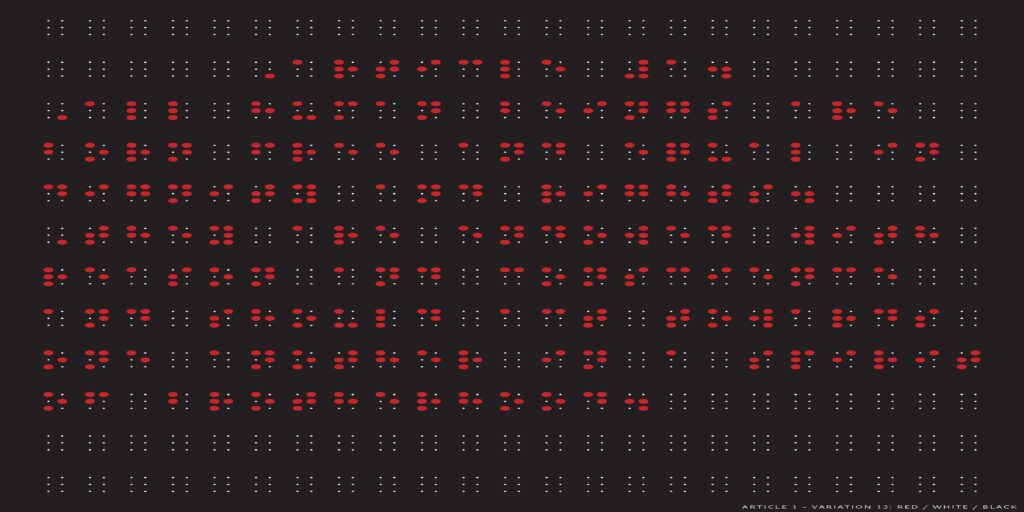
KVB: Architecture is said to be a mirror to the social structure of a society. Since a couple of years, your focus is on the disruption of society, on the moment of collapse. You relate to the concept of conflict as the main organisational principle behind the way things are ordered, conflict governs everything. If I understand it right, conflict is not necessarily a negative, destabilising factor, on the contrary one can even benefit from it?
ODK: With architecture there is the ever challenging need to invent a reason to do architecture, people tend to forget that. The first invention in any creative instance is the reason and the main attribute of any invention is reason. There are two kinds of reasons. One reason which is why, what is the reason for that. The other reason is as in thought, how do you reason on that. These two reasons must be present in order to have a situation to do architecture. I think the notion of conflict and the disintegration of society today is an evolutional phenomenon.
As an integral component of the formation and evolution of a social system, conflict emerges as a significant mechanism that instigates change rather than unanimity. This phenomenon materializes in the form of various vital events such as wars, natural disasters, emigrations, population displacements, birth, death, and choice. These events ultimately become the stimulators and variants in the transformation of societies.
The constitution and composition of a social system involve conflict as a process of modification towards a different future of experience. The evolution in contemporary culture is predominantly forged by conflict or vital events which are instigating new conditions of adaptations and developments. Therefore, conflicts can be understood as a familiar interdependent relationship involving constrains and obligations.
Understanding the conflict phenomenon as a catalyst of socio-cultural evolution, reveals that the notion is a stimulant for improvement and progressive tendency. Therefore the accommodation of conflicts is a prominent objective within all aspects of social planning and intervention.
As humans, we are still in an evolution process biologically. We used to be something and we are humans today, I don’t believe this is the end situation for us. Not only physically does evolution take place, our psyche is changing, our moral values are changing. What we were afraid of, we don’t care about it today.

The notion of conflict has always existed, right from the big bang to creation. The story of Adam and Eve is quite exemplary to this. For me that always has been a fascinating story, how it is told so casually. Adam and Eve could not sustain a relationship with God. There were only three of them and they still managed to fight. Something bothers me with this story. Adam and Eve offended God and God got so angry that he kicked them out of the garden of Eden. Excuse me, the ever-loving God, the ever-forgiving God? Why didn’t Adam and Eve just apologize? No, they just left – probably because they were aware that they were blessed with the ability to wonder. There is defiance in humans. We like to say, to hell with you, I can go my way. We can wonder mentally (in the mind), or physically by movement. And so, they became the first refugees, first displaced persons, and the first occupiers of a foreign land. That is part of our evolution. At every point in our history, those dynamics are present. Uncertainties and chance happening become eminent characteristics of the continuity and consequence of events.With reference to wars, displacements and natural disasters, boundaries are constantly shifting and new territories are being created. These new territories have become the fundamental platforms for innovative solutions and interventions that require a continuous systematic approach. The study of ‘post-conflict rehabilitation’ and ‘rebuilding’ have not been appropriately integrated as essential courses to study in academic institutions such as architecture, design, applied arts, sociology, psychology and literature. This integration is mandatory in order to formulate and represent a continuous reaction.Whenever there is a conflict, it is always due to the need for something else to happen in which the only certainty is change. Everything around is controlled by a force, be it a god, or gravity, or electromagnetism. There are several forces that hold a society together, and bringing these forces in equilibrium is the principle of how things work. The society is a system and physics tells us that disorder in a system always increases with time. The response to that is conflict management; which is evident of how the sun and planets retain their positions in our solar system and across the universe.

KVB: You have a similar criticism to the currently used rebuilding processes after serious war conflicts or natural disasters as you have to architecture in general: it is not adaptive; it does not show any flexibility and it falls back to primitive actions and blueprints. What does it take to create an alternative approach within the routine of responding to a conflict?
ODK: I think that the major inspiration for architects and designers today is looking into the notion of conflict and post-conflict rehabilitation. I believe it is the most dominant aspect of contemporary culture.The integration of post-conflict rehabilitation as an academic course of study is of absolute necessity as it would sustain a constant consciousness and progressive focus on viable proposals and solutions.
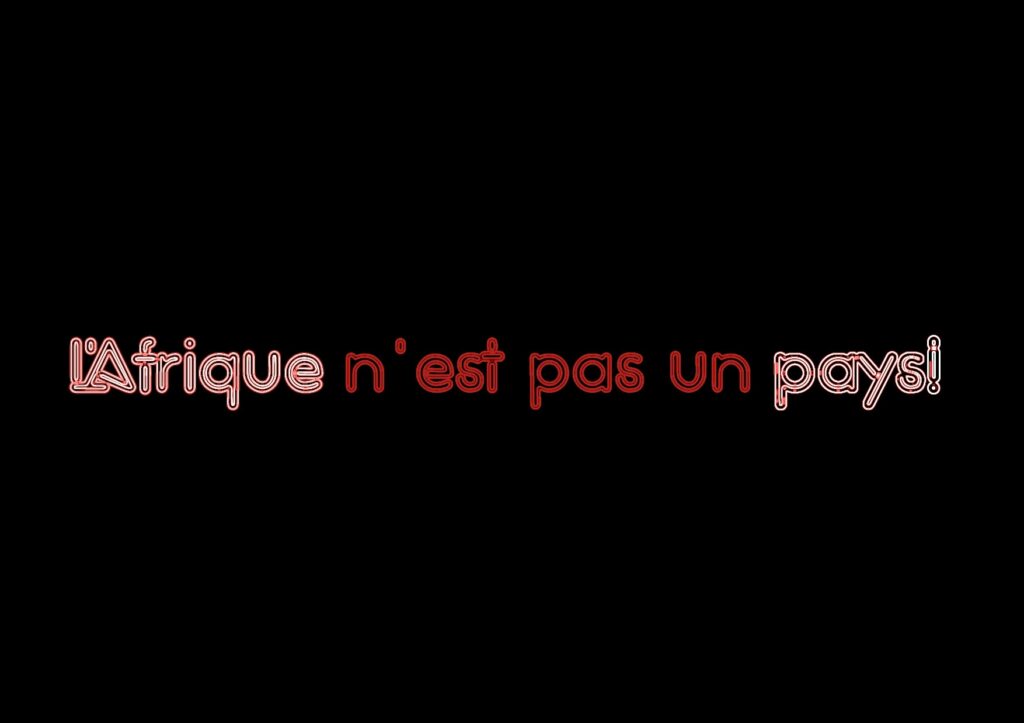
We have new materials in constant production, solutions, inventions, the new tendencies of today such as renewable energy, wireless communication and other technological assets which are still shy of their proper applications. These are more suitable for war or natural disaster conflict situations. The irony is that the new technologies are more adaptable to rebuilding and post-conflict rehabilitation rather than the less effective integration of such applications within the existing social infrastructure. Designers need to work on these situations of need. Normally you build because somebody has a place and they want something else. Today there is this reverse psychology where you have to give people who have lost everything, something else. There is no study for that. An architect has to know the mind of a person who has just lost everything, and they never learn to work with those kinds of situations as a formal education procedure. A whole environment can be full of trauma, bad memories, how do you sanitise such a place, what do you built there? This could also be a very interesting case for visual artists who can discover new applications and meanings for interesting audio-visual installations which could have incredible therapeutic effect. With reference to the history of design, major changes in concept and the use of specific materials have been instigated by ‘post-conflict optimism’ especially after the Second World War. In general, the adoptions of new resistant materials, together with energy efficient interventions, are mandatory requirement in such situations. It would also yield new opportunities for productions, manufacture, new consumers and major economic benefits. My point is that everybody can contribute in this issue; people can have different experiences and formulate different responses to encourage the debate.
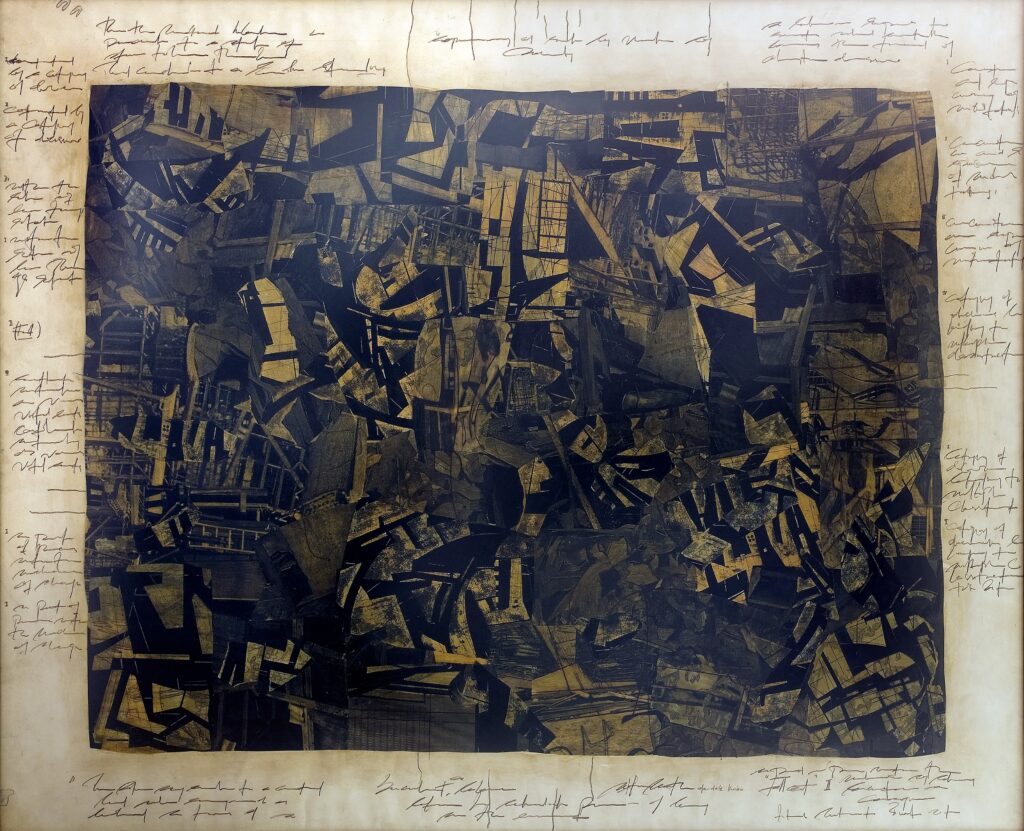
KVB: You have visited war conflict zones like Freetown in Sierra Leone. How can you translate the very complex dimensions of extreme human conditions in disasters zones to something someone can relate to within his own private space?
ODK: It has a big impact on you, being in war zones or disaster situations. The phenomenal environment is a manifestation beyond physical and geographical properties as it includes the intangible and non-material existence of time and space as a medium of continuity; to an end or a beginning, with relative implications on action and perception. Human endeavours are accommodated via the constraints of the non-material medium of time-space geography. The aspiration level of the individual is expressed in terms of a psychological apprehension or contemplation connected to wishes and fulfilment. Thus time-space analysis of the interrelation between people and the social space reveals a synthesis of behavioural, cultural, historical, political and distance geography.
Spatial and temporal constraints are integrated with mechanisms that facilitate and restrain human endeavours and thus reflect on the particularities of communities especially in the disposition and manipulation of the geographic territory and people-environment interdependence.
This is field work and there are the dynamics that really change a mode of thought. You have to experience what such a site is about, because a site to build is not necessarily a plot of land within the city. You get a whole city that is destroyed, where do you start, what is the reference? Maybe you start by helping to rebuild the victims? Can you build something that helps to rebuild what was lost? Is it necessary to ever build there again? Then you realize that a space can loose its transparency as a result of an event. A space could be filled with memories of horror, pain, smell, sound and trauma. Sometimes, to be in a place can be quite distracting because our senses do not always operate in a predictable way. Other senses can just totally take over you and dominate. That is what I learned when experiencing these situations. The experience of being in a war zone has a lot to do with how you respond afterwards, how you can start to think of what is needed; reflecting on what can be an approach to solutions. The aspect of observation or being part of something is a necessity when you experiment.
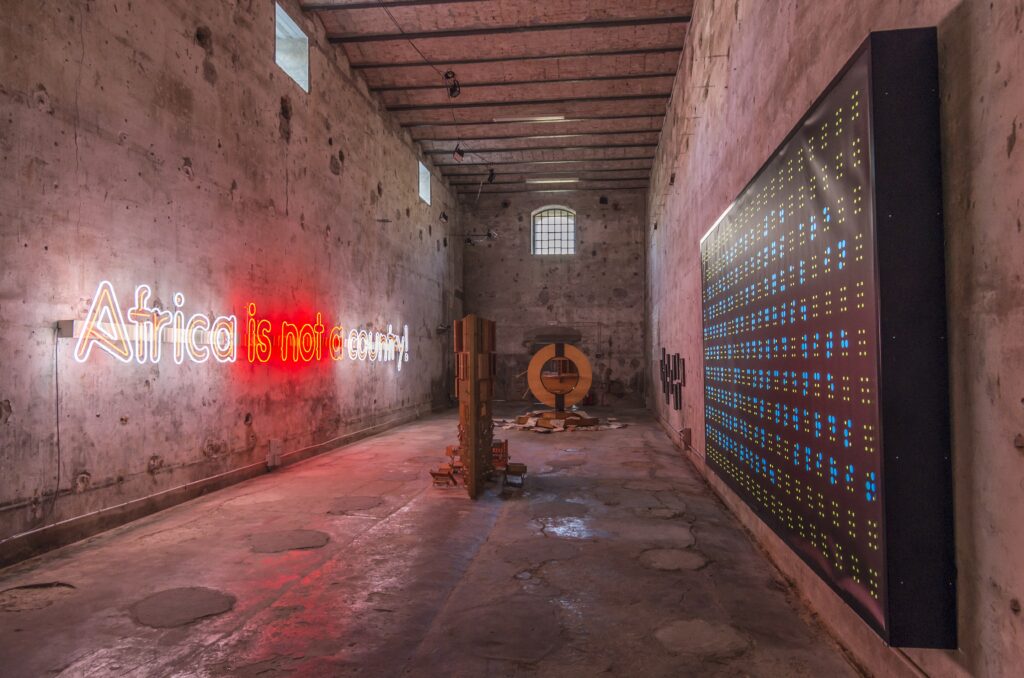
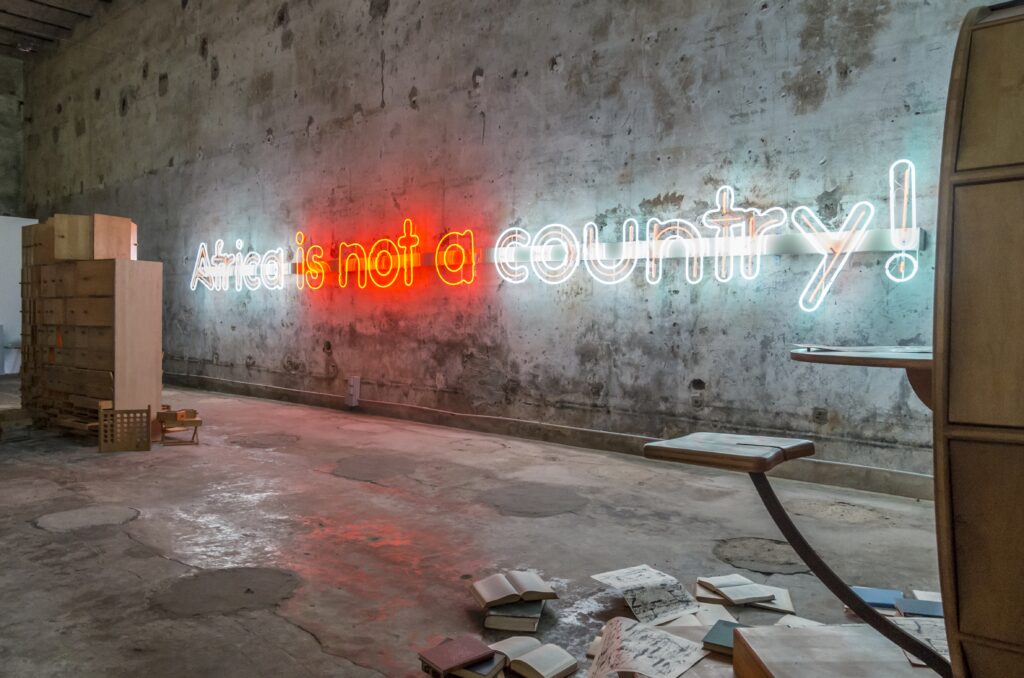
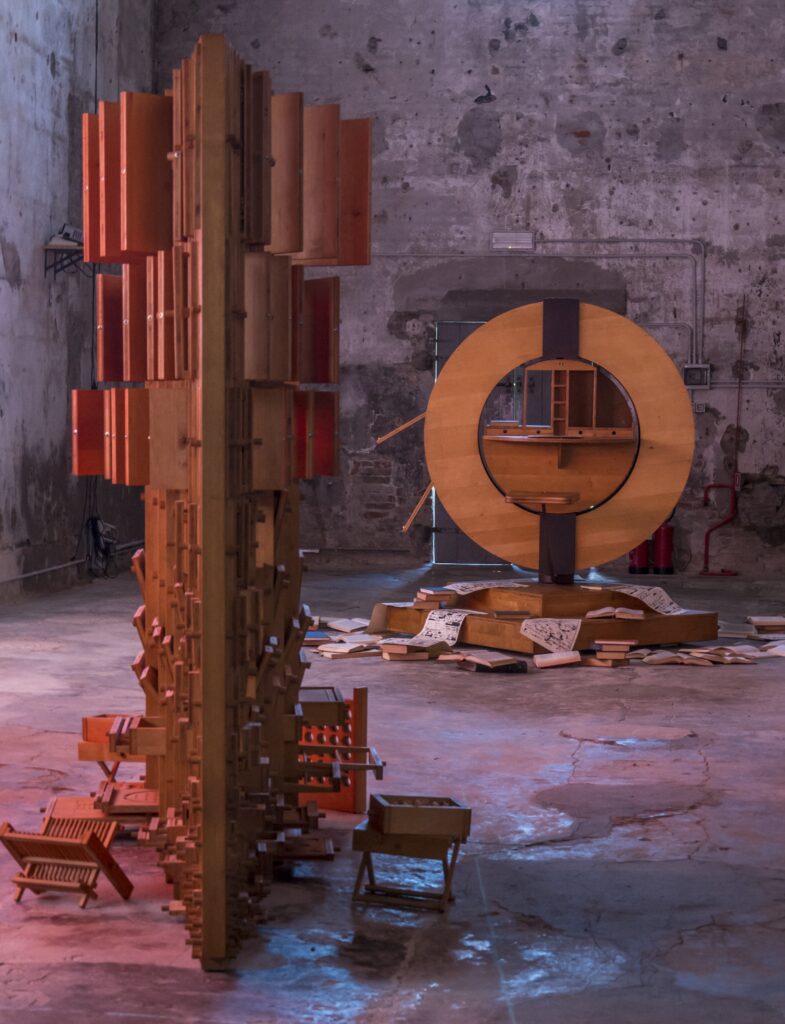
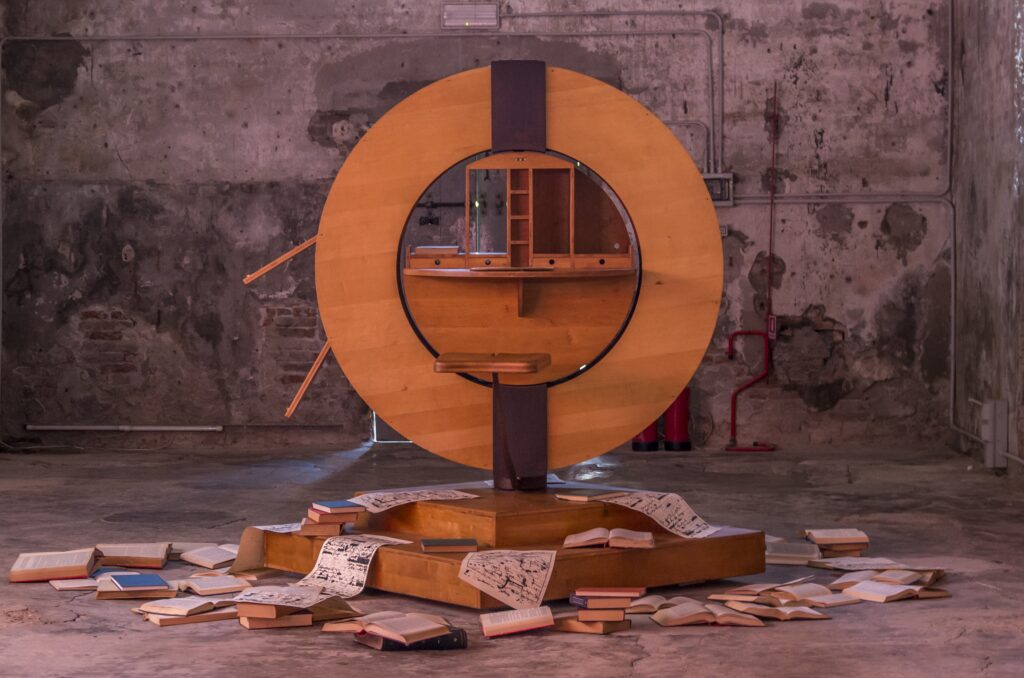
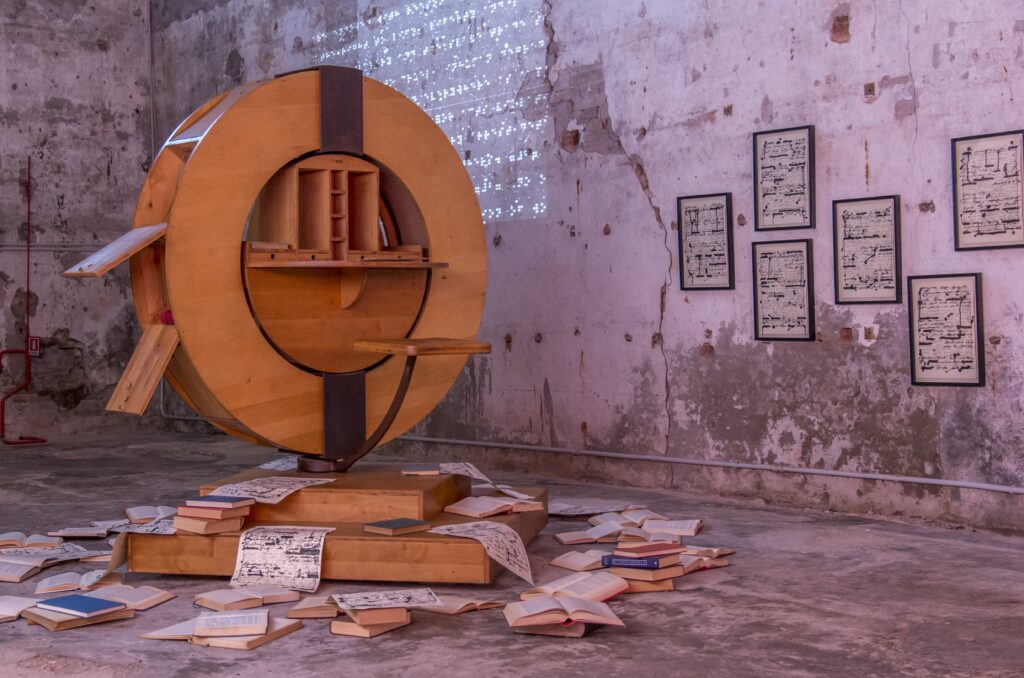
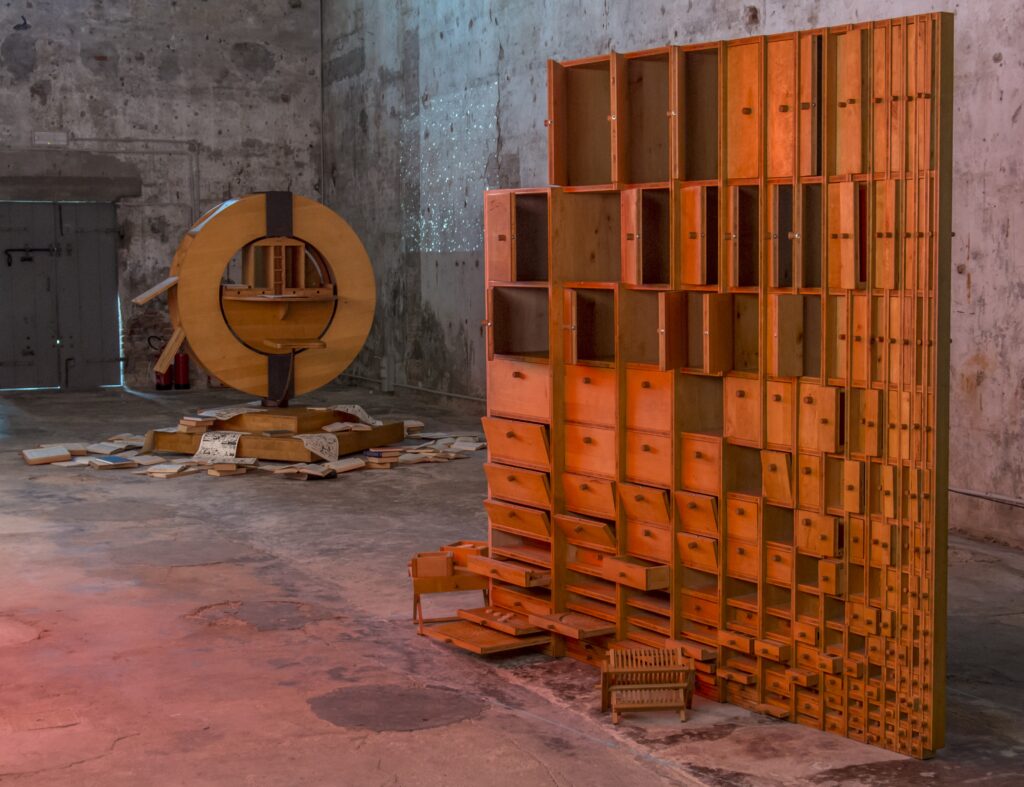
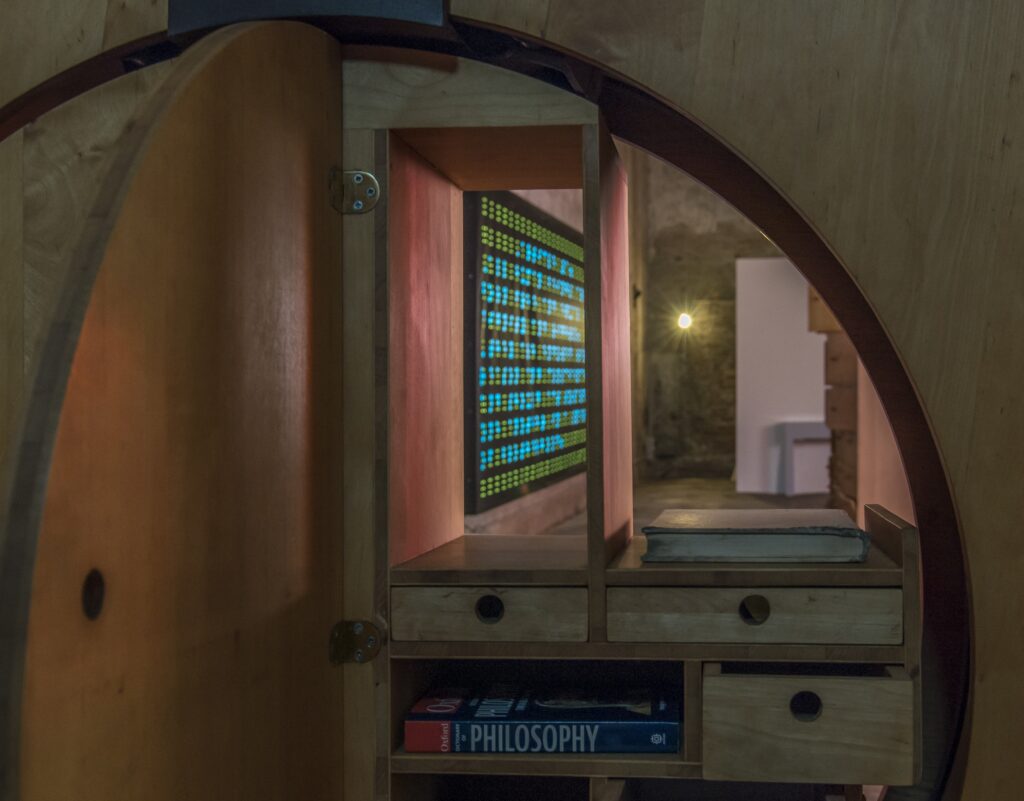
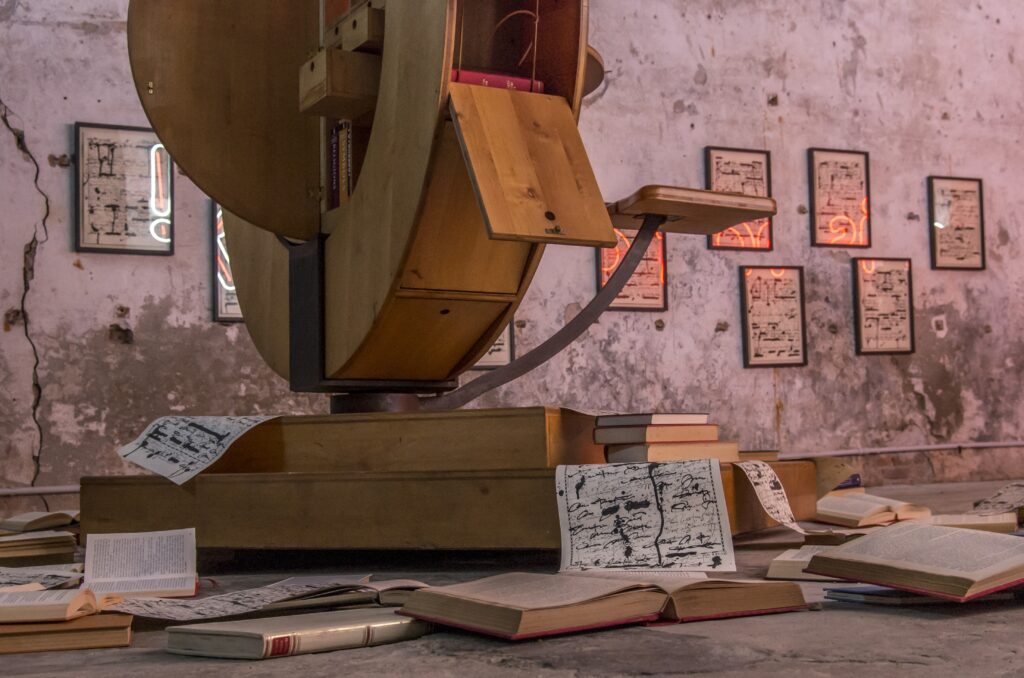
Selected reviews
